









































Letina tanks available from stock at Core Equipment
Worried about running out of tank capacity this year?
To take the stress out of buying tanks for this harvest, Core have secured a significant quantity of both fixed and variable capacity




Letina tanks from 1000 litres through to 10,000 litres. As Letina’s largest European distributor and exclusive UK distributor, our close relationship with the Letina factory has enabled us to secure additional stock for delivery this spring.
Contact the Core sales department to secure yours.
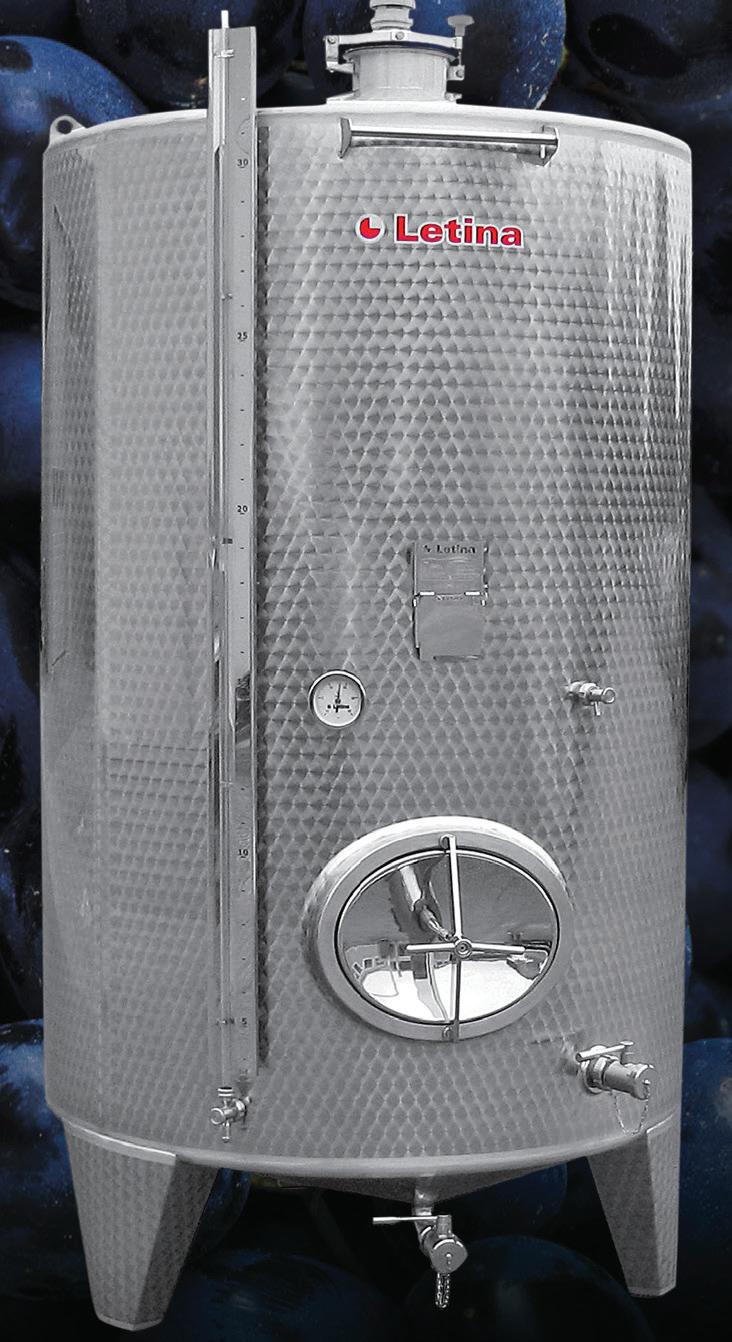

Installation, training, service and maintenance from The UK’s leading Winery Equipment supplier
www.vineyardmagazine.co.uk
VINEYARD
Kelsey Media, The Granary, Downs Court Yalding Hill, Yalding, Maidstone, Kent, ME18 6AL 01959 541444
EDITORIAL Editor: Rebecca Farmer vineyard.ed@kelsey.co.uk
Features: Malcolm Triggs
GRAPHIC DESIGN
Jo Legg Flair Creative Design jo.legg@flair-design.co.uk
ADVERTISING & MARKETING
Jamie McGrorty 01303 233883 jamie.mcgrorty@kelsey.co.uk
PHOTOGRAPHER
Martin Apps www.countrywidephotographic.co.uk
MANAGEMENT
DIVISIONAL MANAGING DIRECTOR: Steve Kendall
PUBLISHER: Jamie McGrorty
RETAIL DIRECTOR: Steve Brown
SUBSCRIPTION MARKETING MANAGER: Claire Aspinall
PRINT PRODUCTION MANAGER: Kelly Orriss
DISTRIBUTION






Opening up new possibilities
Greyfriars Vineyard first featured back in 2022. Mike Wagstaff invited us back to see how things have progressed at this award winning vineyard and winery. 20


The growth of the vine
Vivai Cooperativi Rauscedo, based in Rauscedo in Italy was established in 1933 and for over 90 years has been striving to help growers achieve the best results from their vineyards. 40


Vine nutrition

Ensuring that vines are receiving, and utilising, the correct balance of nutrition is a yearround job, requiring as much monitoring and measurement as it does practical intervention.


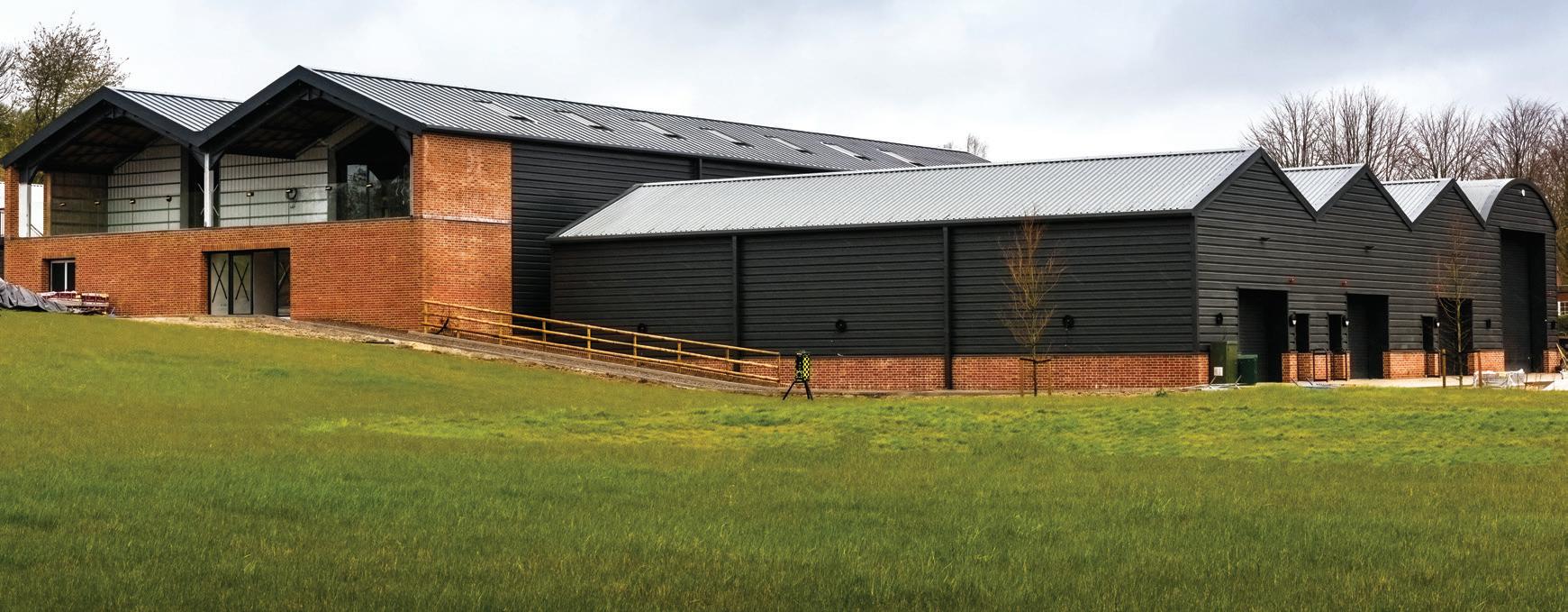
Wine storage
The too-often unconsidered bottleneck for growing production.
















“We are proud to present the diversity of wine making styles.”





















This statement from a menu in Switzerland made me think. This was not the menu of a fancy wine bar nor was it the menu of a speciality restaurant rather it was the menu of a regular commuter train. Under the heading “On the rails with Swiss wine” this menu explained why the only wines available onboard were Swiss and it revelled in the variety and diversity of Swiss wine.










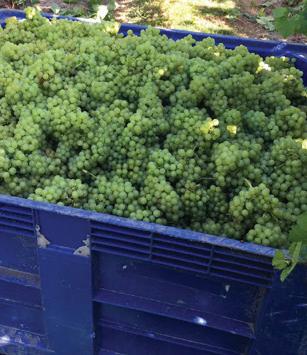








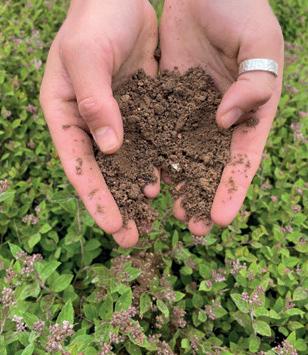

The train travelled past vineyard after vineyard many of which were planted at such angles it would appear those cultivating them would need the sure footed balance of a mountain goat. Whilst taking in the scenery and watching many a vineyard literally pause at the cliff edge and continue on at the bottom of a mountain – I was deliberately being directed to reflect that the wine in my hand was from some such vineyards and it made me appreciate the effort and skill that was required to make this wine. It was impossible not to make a connection to the wine of England and Wales. It has been suggested to me this month that sometimes English Wine if it appears on a menu is often, at best, a token gesture. This is not so true in Wales where if Welsh wine is listed on a menu it is often a point of celebration. There is however a long way to travel before we arrive at a destination where there are 30 wines on a menu from local producers (as was the case in a Swiss Mountain hotel).
All is not without hope however because talking to the proprietor of a London pub who is leading the charge championing home grown products, was very encouraging and also an inspiration (page 16). On a visit to a vineyard in Surrey (page 20) it was great to see so much hard work is being undertaken to bring English wine into the everyday orbit of the general public. Added to this is the success of the recent Welsh Wine Trade tasting (see Matthew Jukes page 18) and the upcoming Welsh Wine Week, these are signs that things are on track and moving in the right direction.
Experiences this month have made me ask the same question that has bothered so many parents on so many journeys.
Are we nearly there?
The answer is… not yet.
VineWorks has been supporting UK vineyards since 2006
VineWorks has been supporting UK vineyards since 2006
SPECIALISING IN:
Specialising in:
• Vineyard Establishment
• VINEYARD ESTABLISHMENT
• VINEYARD SERVICES

Specialising in:
• Vineyard Services
• VINEYARD SHOP
• Vineyard Shop
• Vineyard Establishment
• FRUIT BROKERING
• Vineyard Services
• Fruit Brokering
• Vineyard Shop
• Fruit Brokering










Cool-Climate White Wine Oenology is dedicated exclusively to the technology and science of white still wines and sparkling base wines, as they are produced by the rapidly growing British wine industry and in countries with a similar climate. It has a strong focus on sensory issues and guides the reader through the entire process of white winemaking – from the crush pad to bottling – clearly defining which measures to take and which to avoid.
Volker Schneider, has an industry background, was lecturer of oenological chemistry at Geisenheim University (Germany) and founder of the international consulting firm SchneiderOenologie which specialises in quality control, product development and research.
Mark Tracey, is an emeritus professor of engineering at the University of Hertfordshire with an applied research interest in new winemaking technologies and processes.
Cool-Climate White Wine Oenology is priced £30 and is available through local bookshops and online retailers.
Balfour Winery, one of England’s leading producers, has today unveiled a new logo and rebrand set to feature across all facets of the 22-year-old company.
The new emblem, which is an artistic representation of their state-of-the-art winery, will be rolled out across the business this spring. Meanwhile, all mention of ‘Hush Heath Estate’ on the logo has been removed.
The revamp also includes a major change to the “Jake’s Drinks” beer and cider brand which will also now fall under the Balfour overall name as Balfour Reserve Lager and Estate Cider. These products launched on 1 April across Balfour’s chain of ten pubs, as well as in several retailers.
The roll-out of the new look on Balfour’s wines will begin in earnest with the 1503 range – which is stocked nationwide at UK specialist Majestic. This also includes the removal of the Union Jack design on Balfour’s labels and the introduction of a slanted design which echoes the architecture of the winery.
The Balfour Group’s Marketing Director, Jack Merrylees, hopes the changes will help to simplify the brand – and bring more people into the English Wine category.
“We wanted to bring a fresh new look to the Balfour name – something more modern and elegant. There’s been some confusion in the past about who we really are; Hush Heath, Balfour, Jake’s. This move brings

everything together under one, coherent brand – and we hope that when people see our emblem, whether on our wonderfully accessible 1503 wines, more esoteric releases or beers and ciders, they can trust the quality within”.
As one of the country’s most-visited vineyards, Balfour is already planning for another summer of record-visitor numbers, and Jack Merrylees hopes the new branding can help further entice visitors to their Kentbased winery, which is just 45 minutes by train from London.
“This evolution of our branding showcases
what makes Balfour truly special; our home. Our biggest asset as a brand is our incredible winery – and the 400 acres of wildflower meadows, ancient woodlands, orchards and vineyards which surround it. So getting a representation of that home on our labels and on shelves across the UK is key for us.
"We’re excited to get this branding live across our physical sites too, at the winery and in our ten pubs. As part of this rebrand we’ll be launching new brand campaigns, a new website and new collateral, all to futher connect the Balfour Winery name with our incredible home,” added Jack Merrylees.


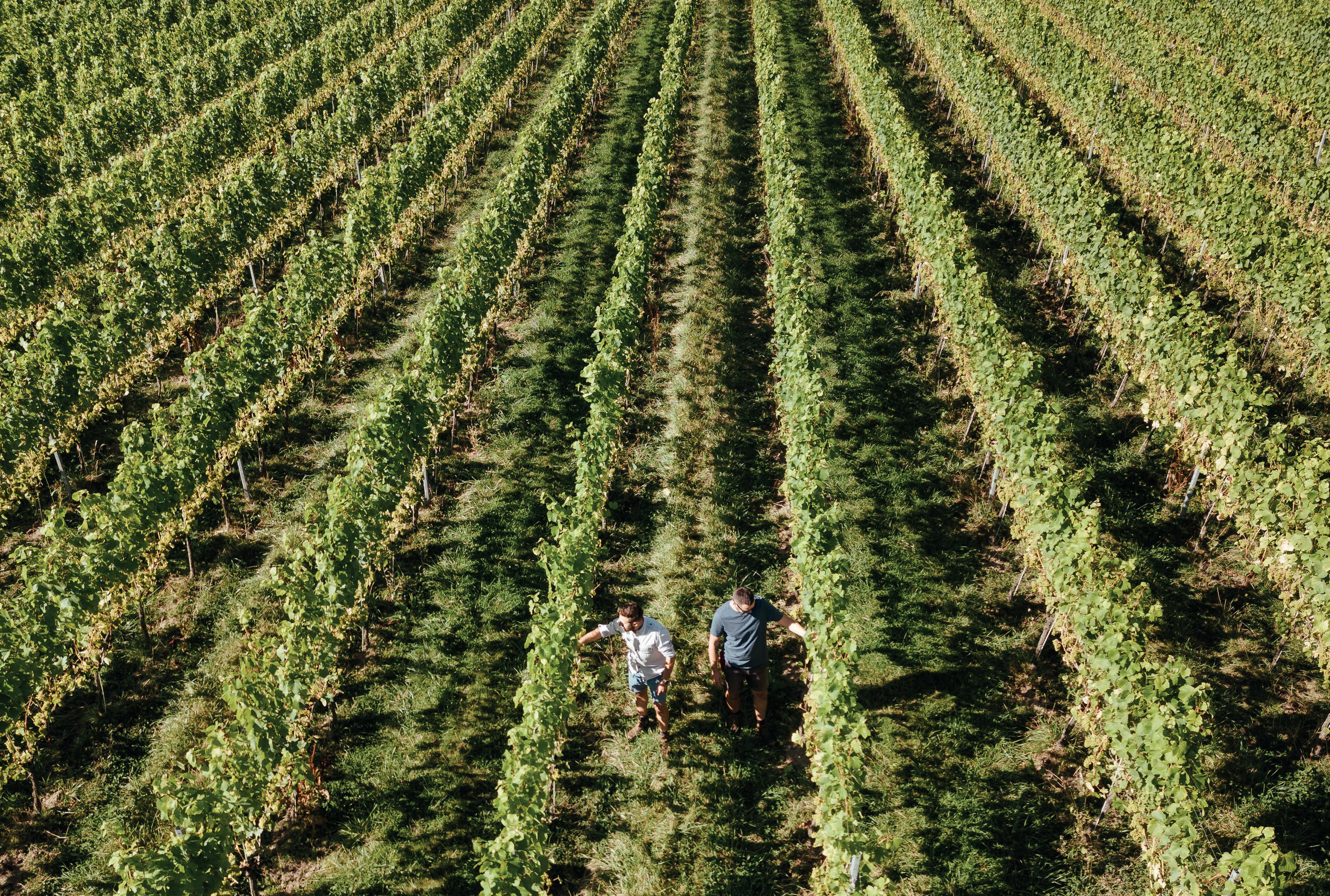
Vinescapes is the UK’s Premier vineyard and winery consultancy - precision viticulture from ground to grape to glass. Our team have the knowledge and expertise to deliver exceptional vineyards, which lead to exceptional wine.
When it comes to your vineyard or winery, we take care of everything. We’re a turnkey solution, get in touch, and we’ll show you how we can make it all happen for you.




Owen Elias has been supporting the production of Nutbourne wines for 28 years – originally under contract at Chapeldown, and since 2010 at the vineyard's own winery.
Working with the Gladwin family, Owen has shaped the Nutbourne range and achieved some wonderful results, including development of the famous field blend, Sussex Reserve, that was the first English still wine to win a gold medal at the IWSC, as well as the classic method sparkling Nutty Vintage, a past winner of the Gore Brown Trophy wine of the year. Owen has decided to focus his consultancy on bigger producers, including
Balfour and Artillium. He will be missed at Nutbourne but his great contribution will never be forgotten.
The Gladwin Family are delighted to welcome Emma Rice, previously winemaker and Director at Hattingley Valley, as their new consultant. Emma has worked at wineries around the world, is a previous winner of ‘UK Winemaker of the Year' and brings both global experience as well as great expertise. She will be working with the family to maintain quality, further
The Grange has production capacity available for premium traditional-method contract winemaking.
We can deliver a fully traceable service from grape-reception through to packaged bottles and are looking to build long-term relationships with clients from across the UK with a minimum of 4ha of vineyard planted or planned.
Interested parties should send enquiries to harry.pickering@thegrangehampshire.co.uk
developing the Nutbourne range and coaching Gregory Gladwin in his winemaking techniques.
Nutbourne is a single estate vineyard originally established in 1979, now owned by the Gladwin Family. Their wine production and farming activities operate alongside their group of Local and Wild restaurants in London, which include The Shed in Notting Hill, Rabbit on the Kings Road, Sussex in Soho, The Black Lamb in Wimbledon Village, and very soon, The Pigs Ear in Chelsea.


£20m available
Farmers, foresters and other land managers are encouraged to apply for the Woodland Carbon Guarantee scheme ahead of the eighth auction, which will take place online from 23-29 September.
Administered by the Forestry Commission, the Woodland Carbon Guarantee is a £50m scheme that aims to help accelerate woodland planting rates and remove carbon dioxide from the atmosphere and has already resulted in nearly 3,000 hectares of new woodland across the country.
£20m is now available as part of the eighth auction, for farmers and land managers to create new woodlands to help tackle the effects of climate change, providing new income in the form of long-term payments for the amount of carbon a new woodland will store. Woodland creation also provides a wealth of other benefits from helping to reverse biodiversity decline and increasing green jobs to aiding physical and mental health.
Following an online auction process, successful bidders will be offered the option to sell woodland carbon in the form of Woodland Carbon Units – a financial value given to each tonne of carbon stored –to the Government up to 2055 at a guaranteed price protected against inflation. The scheme reflects the Government’s confidence in the continued growth of markets for woodland carbon, as landowners will continue to benefit from a reliable revenue stream in selling carbon on the domestic market.
For the first time, the auction will be opened up to farmers, foresters and land mangers whose projects are not currently in receipt of Government funding to allow an even greater number of woodlands to benefit from the auction. These projects will have access to a higher, undisclosed reserve price per Woodland Carbon Unit. Projects can still
receive the Woodland Creation Planning Grant to support the design process and remain eligible for this new category.
Richard Stanford, Chief Executive of the Forestry Commission, said: "The Woodland Carbon Guarantee continues to be a huge success, providing additional financial surety for nearly 3,000 hectares of new woodland across the country, helping to address some of society’s biggest challenges including climate change and biodiversity loss.
“The eighth auction is a great opportunity for even more farmers, foresters and land managers to reap the benefits of this scheme by receiving a guarantee of future additional income for increasing tree cover across the country and I encourage as many as possible to apply by 6 September.”
Before applying for the Guarantee, land managers will need to have registered with the Woodland Carbon Code, which provides the tools and information required to verify and record the carbon they are capturing and can sell in future.
Previous auctions have seen a considerable number of contracts offered by the Forestry Commission to stimulate proposals for the creation of new woodland specifically to help combat climate change. The Government has stretching and challenging targets to increase tree canopy and woodland cover in England to at least 16.5% by 2050, and continues to take action to meet this with more than 15 million trees having been planted this parliament.
REGISTER WITH THE WOODLAND CARBON CODE: www.woodlandcarboncode.org.uk
APPLY FOR THE WOODLAND CARBON GUARANTEE: www.gov.uk/guidance/woodland-carbon-guarantee
To celebrate English Wine Week in June 2024, Denbies Wine Estate in Dorking is launching a Premium Wine Tasting Trail.
On Friday 21 June, the Denbies wine train will depart from the Surrey producer’s Vineyard Hotel at 12:30pm and again at 5:30pm.
Ticket holders will enjoy a leisurely ride through 265 acres of vines, stopping to appreciate the breath-taking views across the vineyard with a glass of Denbies English award-winning sparkling wine.
After the train ride, guests will alight at the Vineyard Terrace to be guided through a tasting of six of Denbies premium wines by their own WSET (Wine & Spirit Education Trust) expert. The tasting experience

includes a selection of light nibbles and cheese platter consisting of locally sourced produce to share between two.
From the Terrace, visitors can take in the outstanding views over the estate and winery – the perfect way to soak up a beautiful English summer’s afternoon or evening.
The complete tour will last approximately 90 minutes, with a Denbies vineyard guide on hand to point out highlights throughout the wine trail experience.
Tickets are £75.00 per person (18+ only).See the website for more information and to book: www.denbies.co.uk/fc-events/eww-wine-trail/

The sell-out Vineyards of Hampshire Fizz Fest is returning for its tenth year, showcasing Hampshire's world class still and sparkling wines. This year the event will be held at The Grange, The Winery at Burges Field Vineyard on Sunday 23 June, 12pm to 4.30pm.
This longest standing English Sparkling Wine festival offers attendees the chance to taste more than 20 world class Hampshire sparkling and still wines. Wine makers and vineyard owners are on hand to showcase their wine portfolio including new vintages.
This year the event will coincide for the first time with English Wine Week (15 -23 June) ending a range of local celebrations promoting Hampshire wines.
The Grange’s winery adjoins Burges Field Vineyard, home to 52,000 vines which produce the award-winning range of The Grange wines.
“Fizz Fest provides the perfect opportunity to taste all of the best wines to be found in Hampshire and we are very much looking forward to hosting this showcase event and we are all proud for it to have reached its 10th year. We opened our state-of-the-art winery here in 2022, a splendid design with the purpose of servicing our young vineyard and
Deer Park Wines are incredibly excited to announce the launch of the first Bredon Wine Fayre taking place on 29 June 2024.
A number of local wine producers will be in attendance including, Woodchester Valley, recent winners of the prestigious Global Masters Sauvignon Blanc trophy, Three Choirs vineyard, DWWA gold winners 2023, Welcombe Hills Vineyard, Stratford upon Avon, The Dell Vineyard in Monmouthshire and multiple DWWA award winning Deer Park Wines.
During the day, there will be masterclass tastings, as well as Vineyard tours, talks from

blending and producing our own wine. This year we are now able to do just that,” said Zam Baring, Managing Partner for The Grange wines.
During the day, the tasting tent will host wines and new vintages from all eight members: Black Chalk, Danebury Vineyards, Exton Park, The Grange, Hambledon, Hattingley, Louis Pommery England and Raimes.
In parallel visitors will also be able to take part in a range of new masterclasses including presentations from wine makers and wine pairings. Tours of the winery and vineyard are available all day.
TICKETS (21+ only): £35 pp admission to VoH Fizz Fest including wine tastings + booking fee
MASTERCLASSES: £25 + booking fee (with general admission ticket only
VINEYARD TOURS: £12 + booking fee (with general admission ticket only)
Book via: Eventbrite and www.vineyardsofhampshire.co.uk
expert growers, makers, and sommeliers as well as free tastings from the vineyards.
The event is being held at the spacious Deer Park Hall on the slopes of Bredon Hill overlooking the vineyards and will be open from 12pm-6pm.
There will also be live music and a selection of quality local food vendors, including The Beefy Boys.
The event will be a showcase of quality
English/Welsh Wine both sparkling and still with well known varieties such as Chardonnay and Pinot Noir as well as exceptional Bacchus and exciting wines made from varieties like Solaris and Reichensteiner.
The quality of English and Welsh wine is exceptional, and Bredon Wine Fayre relishes the opportunity to surprise people and to challenge and change their perceptions of English and Welsh wine.
This year’s London Wine Fair – just around the corner – is set to be the biggest in recent years, with wines from over 40 producing countries taking part, from off the beaten track finds from Armenia, Belgium, Japan, Serbia and Ukraine to the stalwarts of France, Italy, Australia and South Africa.
Closer to home, the 2024 London Wine Fair will see the largest turn out from English and Welsh producers to date. Eighteen English wineries, including Defined Wine, Giffords Hall, Halfpenny Green, Silverhand Estate/ MDCV, House of Coren and Radlow Hundred are set to take part in the Drinks Britannia section this year, an increase of 50% on 2023.
Sustainability will again be a central theme for this year, spanning regenerative farming, logistics, climate action and opportunities within a circular economy. In addition, there will be a number of new features and content, including: the Taste Discovery Zone, a new feature which will showcase all non-wine drinks to showcase the breadth of products now available; and The Buyers Concierge Programme, which has been tailored for the 50 top UK buyers. The London Wine Fair Wine Buyers Awards are back for 2024, with two new categories: best on-trade buying team and best off-trade buying team.
A highlight for 2024 will be "Judgement of London", an homage to the late Steven Spurrier’s landmark “Judgement of Paris” Tasting of 1976. Judgement of London will feature two flights: European vs Rest of World Icons Tasting with a white followed by a red flight. The flights and scoring system are being curated by Ronan Sayburn MS, CEO of The Court of

Master Sommeliers, alongside wine writer and highly respected tasting judge Sarah Abbott MW. In an update to the original format, which saw current vintages of Bordeaux and Californian wines compared, the 2024 version will see a broader number of countries participating. The tasting panel will comprise around 20 judges of the industry’s most discerning palates, including leading buyers, top sommeliers, and wine writers. The tasting will take place at the show on Monday 20 May, with the results announced on centre stage during the Fair.
As always there will be an unrivalled schedule of masterclasses, seminars and briefings at the show. Highlights include a seminar in the Education Zone hosted by Positive Impact Concept on Climate Tech: the potential of the circular economy at 12 noon on Tuesday 21 May and a session on Regenerative Viticulture with a panel curated by Anne Jones of Limestone & Jones, which will take place on Centre Stage (2pm, Wednesday 22 May).
Hannah Tovey, Head of London Wine Fair, said: “The Fair has always been a platform for the UK industry, from launching new products to showcasing the most exciting innovations and trends, as well as tackling the more challenging issues of the day, such as the on-going effects of Brexit and legislation. For those working in the drinks industry, it is an unmissable three days of business, education, and networking. We are particularly delighted to welcome so many UK wineries to the London Wine Fair this year and we look forward to seeing a busy three days within Drinks Britannia.”

Monday 20 May: 10am – 6pm
Tuesday 21 May: 10am – 6pm
Wednesday 22 May: 10am – 5pm
To register, please visit: www.londonwinefair.com
At an event hosted by Wiston Estate near Pulborough in West Sussex, producers of exceptional award winning wines and the home of the highly regarded Chalk restaurant, vineyards from all over the South East gathered to celebrate the launch of the brand new WineGB South East Map.
The South East of England has been rapidly garnering attention as a premier destination for wine tourism. Recognising the need to connect wine enthusiasts with the plethora of award-winning vineyards and wineries in the area, WineGB South East has developed an interactive map featuring 45 esteemed producers from the region. Graphic design maestro Lila Hunnisett has lent her creative prowess to the project, crafting a visually stunning map that beckons exploration.
The newly unveiled map serves as a comprehensive guide for tourists, providing valuable information to plan their wine adventures. Spanning across multiple counties, it highlights accessibility, wine tours, shops, bars, as well as dining and accommodation options.
The launch event was a delightful affair, with vineyard representatives, vineyard tourism businesses and press coming together to celebrate this significant milestone. Many of the vineyards brought along current and new vintage wines to toast the celebrations and share an ignited passion for English wines.
The success of the WineGB South East map launch wouldn't have been possible without the dedication and hard work of individuals like Belinda Mercer from Wine GB South East, who played a pivotal role in organizing the event. Special recognition is also due to Fergus from Balfour for his outstanding master of ceremonies skills, adding flair and excitement to the evening. A big thank you must also go to Wiston Estates for hosting and Rick and Kirsty Goring for their wonderful hospitality.
The maps are set to be distributed throughout the South East, in many tourist hotspots, all of the South East Vineyards, all of Balfours many pubs, and Gladwin Bros restaurants in London. The map promises to be a trusty companion for exploring the region's vibrant wine culture. For those unable to get their hands on a physical copy, the map is also available online at www.winegbsoutheast.com.




Alice Griffiths is a wine communicator boosting the profile of English and Welsh Wine on social media, under the popular handle of Posing With Alcohol. Alice has worked within the agriculture industry for the past 20 years, spending time as a lecturer and a smallholder before discovering her passion for viticulture, winemaking and wine tasting.
Get in touch to have your events featured: ✉ Posingwithalcohol@gmail.com
INSTAGRAM Alice can be found on social media under @posingwithalcohol on Instagram.



Four urban wineries based in London held a trade tasting on 25 March 2024. The winemakers club was the venue chosen for the day and Renegade, Blackbook, Ldn Cru and Vagabond all came together in the atmospheric venue situated in the vaulted arches of Holburn viaduct.
The candle lit venue has a great wine history and is sprinkled with fascinating wine paraphernalia but it was slightly disappointing that it had been chosen as a venue to host a celebration of English urban winemaking when neither the onsite bar nor the shop carry any English wines.
Putting the disappointment of this realisation to one side, the Urban Winery Event was busy and it was encouraging to see plenty of visitors throughout the day. The diversity of English wine styles was designed to truly capture the imagination.
Winemaker at Vagabond, Jose Quintana had a good example of what recent legislation changes have made possible with the production of a Piquette. Aimed at the growing No/Low alcohol market and making use of a waste product, Piquette may have been an experiment but it was quite a talking point on the day. “This winemaking fits very well with the playful nature of Vagabond,” said Jose.
Renegade had a Pinot Noir wine in a magnum format from 2020 that contained a mix of 60% Italian, 20% German and 20% UK grapes. Made at the winery in Walthamstow this unique blend is a fine example of how the winemaking team are willing to push the traditional boundaries. After all the company moto is “breaking the rules, one bottle at a time.”
Ldn Cru had a busy day and the Pinot Gris Sparkling Rosé 2022 was popular with both press and trade visitors alike. “The great colour is achieved with five days of skin maceration,” winemaker Alex Hurley explained. There was more good news from Ldn Cru the only Urban winery in attendance to have their own vineyard. For 2024 there will be a new block of Bacchus vines planted at Foxhole vineyard.
Blackbook also had a treat for those at the tasting with news of the release of Headlights On, a truly limited edition (120 bottles) which is a collaboration between Blackbook urban winery and Wild Nothing, an Indie rock project. Headlights On is a traditional Method Seyval Blanc aged for four years. The wine can be ordered as a bundle alongside the album ‘Hold’ on which the track Headlights On can be found.
The variety and imagination presented at this Urban Winery trade tasting were great to see and the future of urban winemaking looks very exciting indeed.



Our facility maintains a consistent temperature and humidity level.
Store your wines securely without incurring custom duties or taxes.
Full-time CCTV and alarm system.

Flexible storage plans for all types of storage types and durations.
07557 539458
The Old China Hand Pub in Clerkenwell has been providing a relaxed atmosphere and a great place to spend an evening for nearly two decades. It is in an historic and bustling part of London that has featured in novels from Dickens but proprietor Rowena Smith is writing her own story her own way.
In times when pubs have often lost their individuality or have been converted to restaurants it is lovely to find a pub that offers the chance to play board games and darts or maybe watch the Six Nations but the Old China Hand is more than this – it is truly unique. The fabulous hand painted street art outside the pub is perhaps a hint to what surprises may be awaiting the visitor.
Many of the vineyards featured in this magazine have amazing stories to tell and Rowena has gone to great lengths to stock products that celebrate stories from the British Isles. There is nothing in this pub that has come from outside this region including beer, spirits, snacks, cider and of course wine.
“People don’t believe it when they hear that the only products we stock are from the British Isles. One customer said ‘your wines can’t be’ but they are,’” she said with pride. When people ask why? Rowena has a perfect reply “I really want to promote products from the British
Isles,” she said in a matter of fact way.
Rowena explained that previously she had a restaurant and a bed and breakfast in Harrogate and she felt very nervous when people ordered wine. “People could be very difficult about wine,” she said. To counter this problem Rowena explained that she started to buy English wine, “I did my research and knew the grape varieties and what they should taste like and people didn’t always know as much as me, so I was in the driving seat,” she said.
Rowena has a passion for the food and drink sector in London. “As soon as there is a review of a restaurant I am there,” she said. This passion is evident in the diversity of products that are stocked at the Old China Hand. The amount of effort that it takes to pull together a pub with only products from the British Isles is immense and Rowena is always on the lookout for new suppliers.
Rowena has visited vineyards in Somerset, Dorset and Sussex and

DESKTOP www.noordinarypub.com LOCATION-DOT 8 Tysoe Street, Clerkenwell EC1R 4RQ �� Wednesday - Saturday from 5pm

will visit tastings and wine fairs in order to research wines for the pub. She also undertakes a lot of internet research to find suppliers. “I am also very proud of our beers. We rotate our beers and I work really hard to find the right beers. We have a stout that people really enjoy and I tried so many before I settled on this one.”
One of the biggest problems that Rowena faces is getting wines at the right price point. Here she praises Knightor, who have worked with the Old China Hand to develop a price point that both parties are happy with. Knightor were willing to work with Rowena because they really appreciated what she is trying to do in this busy metropolitan street. In fact thanks to Knightor, customers at the Old China Hand are able to buy a Merlot, Cabernet Sauvignon wine grown in England.
As a pub there is a limit to what Rowena can charge for a wine, “I don’t think our customers are cheap here on the whole, our customers are willing to pay a reasonable amount if they enjoy a wine,” she said loyally.
Talking about rosé Rowena explained that it is very popular but that it is quite difficult to sell a dark rosé. This is a point that crops up in conversation with wineries and retailers on a regular basis and it appears that even here wine drinkers are led by their eyes.
Many of Rowena’s customer are locals, about 90% are returning customers. “When I say I wouldn’t swap my customers for the world, I really mean it, they are lovely,” she said with warmth in her voice.

Talking about introducing new customers to the wines that are available Rowena explained: “When a customer asks for wine and red wine in particular, I always say I have two reds and I give them a healthy taste of each before I tell them they are English reds. The Italian and the French visitors are the most difficult. I always say to them I enjoy and drink your wine so why not try this wine but they will never say it is good,” she said with a smile.
The choice of wines is substantial and both still and sparkling wines from suppliers such as Biddenden, Knightor, Silverhand and Kingscote ensure that Rowena’s customers will have a wine to suit them.
One area that Rowena would like to increase is her offering of Welsh Wine. The Welsh National Choir will soon visit the pub for a music night so it was great that Rowena was able to reconnect with Montgommery Vineyard at the recent Welsh Wine tasting at the London Welsh Centre. “They had slipped off the list after Covid-19,” Rowena explained. It was nice to see first hand trade tastings working well for both vineyards, suppliers and ultimately the end consumer.
What Rowena has done at the Old China Hand is make products from the British Isles the central focus. To make these products a regular part of everyday life in a bustling part of the metropolis is really a fantastic achievement and I hope that in time many will follow where she is leading.


It is always a pleasure to shine a spotlight on Welsh Wine Week, which happens between 25 May and 2 June this year.
This time, my digging around to find great wines was a doddle. These cunning dragons held a particularly impressive tasting in London last month at the London Welsh Centre, and I was one of many interested parties in attendance. While Welsh wine still seems somewhat of an anomaly in the greater consciousness of the UK wine trade, I can assure you that if you were ignorant of this event, then get on the radar, and if you found yourself a little too busy, sort your diary out.
This was a pivotal celebration, with eight committed wineries showing their finest wines to date. I only have space to highlight three bottles in this article, but I found much to admire in all corners of the room.
Among assembled VIPs, I was fortunate to rub shoulders with several influential wine communicators and our very own editor, Rebecca Farmer! In essence, this was the finest Welsh event to date, not least
NV Ancre Hill Estates, Blanc de Noirs
£42.18
For more information on stockists, please visit www.ancrehillestates.co.uk
I visited Richard and Joy Morris in the dim and distant past, and they are pioneers in their (literal) field. While I would love to recommend their entire portfolio, I cannot. Some of their wines are just too edgy and complicated for my tastes. I am a classically trained old fart whose flavour boundaries were set some half-century ago, and while the Morrises move things along with their creative pet nats and the like, I prefer to settle into my lounger with a glass of this terrific BdeN.
I love their Bio-worthiness and I respect their zero-dosage stance. I adore the four-year-long lees contact and lack of interventions during the entire making of this wine. But what I value more than any of these badges is the flavour of this deeply invigorating and resplendent wine. This is not only a decent Welsh drop but also a wildly delicious Pinot Noir that teases all the senses with its restless energy and eventual completeness. I take my hat off to you Morris folk – you did it. You made sense of the white noise surrounding Biodynamism and the fervent and oft misguided no/lo-intervention movement and ‘grew’ great wine in a world where hundreds of others failed.
















because the number of wines shown was the largest but also because I started to sense a collegiate feeling in the room, which is critical to any vinous marketing plan.
Of course, there were more than three highlights among the wines on show, but there is still some way to go before I am truly spoilt for choice. I have been writing about serious Welsh wines since 2010, and while I am time poor and perpetually drowning in samples from all over the planet, I always take the time to focus on wines from across the border. It is inbuilt – I am English, the Welsh are near neighbours, and we are soulmates (unless we are talking about rugby)! So, when I walked into this tasting, I knew that my focus was to determine the three most important and commercially relevant wines in the room.
Read on for my top trio, and I am sorry to those wines that sat in fourth, fifth and sixth place… I know who you are, and you will get a good swing of the bat before too long.
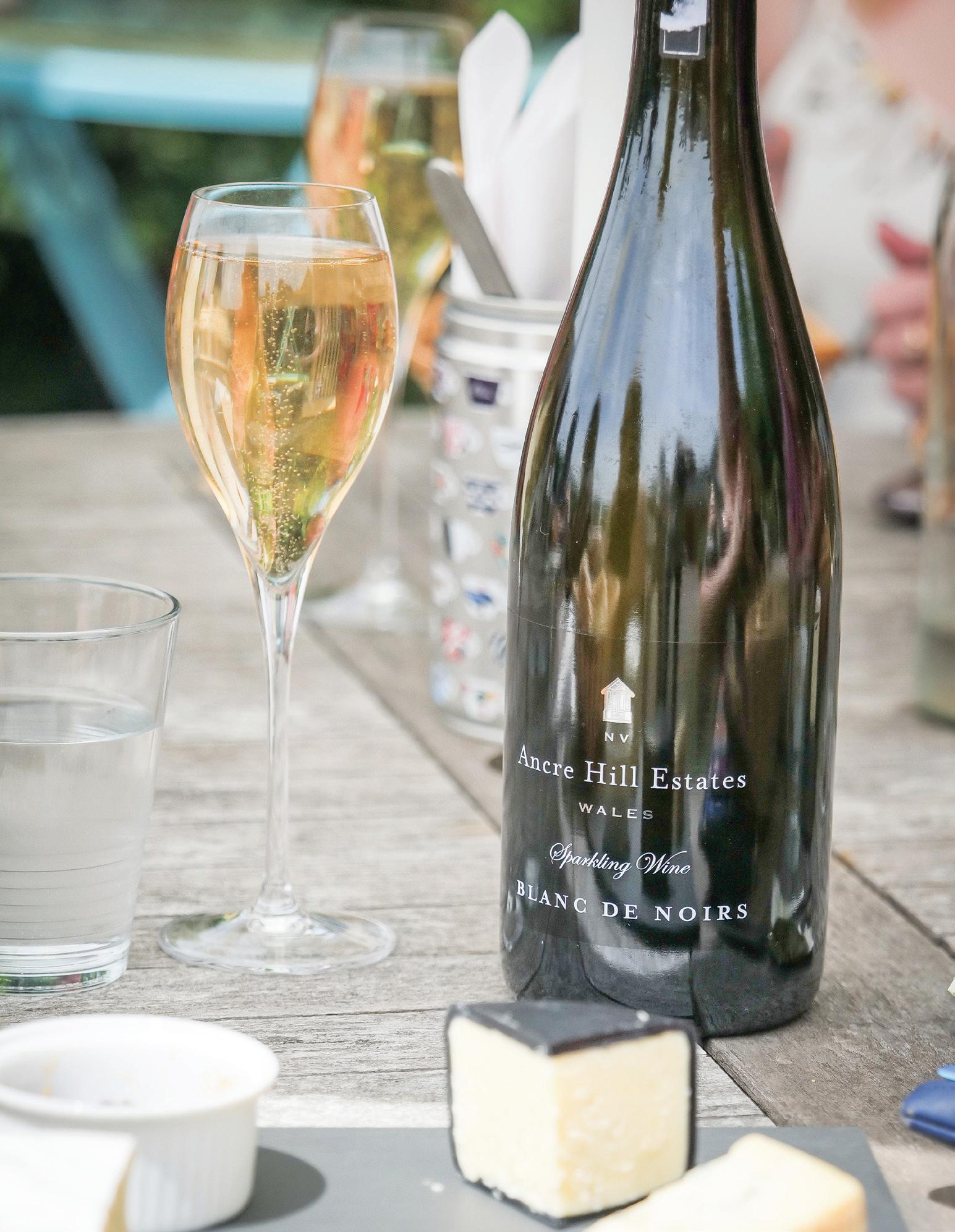
£22.00
www.whitecastlevineyard.com

Robb and Nicola Merchant have done an excellent job banging the Welsh wine drum for as long as I can remember. Their wines are all noteworthy, and my problem here was which should I pick to trumpet their wondrous song.
As it happens, I may have chosen a wine they least expected, but I know my reader will adore it. This new season rosé, made from 40% Siegerrebe, 40% Phoenix and 20% Pinot Noir Précoce, is a little beauty. It has a floral nose, a generous mid-palate (often missing from those skinny numbers over the border) and a fabulous, long, dry finish. More importantly, it does what us thirsty drinkers desire – it fulfils the promise.
£24.50
www.valevineyard.co.uk).

Check list: it’s summer, I need rosé, I want to support Wales, where do I spend my twenty quid? Answer: White Castle Vineyard. We all know the rest of the world offers you all the choices you never wanted, but this year Wales answers the question with this wine. Drink it, and you will see that I am right.


This wine won a silver medal at the Welsh Vineyard Association awards last year, and the only question I have is, what on earth could have beaten it?
This is a stormingly delicious wine, and when I waltzed around the room, I thought the 2022 Vale Vineyard Cabernet Noir/Divico/Rondo blend, drearily entitled ‘Red Wine’ in the tasting booklet, was a beauty until this ‘Reserve’ level red, was unleashed.

Made from 80% Pinot Noir Précoce and 20% Divico and fermented in stainless steel before being transferred to barrels for nine months, the astonishing thing about this wine is that the vineyard was planted in 2019.
While I am familiar with the ‘first crop phenomenon’, this wine blows even the most delicious of these candidates out of the water. As an aside, the wine ninjas at Halfpenny Green were employed to usher this wine into the bottle, and they never let anyone down.
You can summon all the Lord of the Rings or Game of Thrones analogies you like, but nothing comes close to this dragon awakening moment. Get in quick – this is a micro-production wine.









It is always great to catch up with vineyards and witness fi rst hand how they are progressing on their journey. Greyfriars Vineyard on the Hogs Back in Surrey fi rst featured in these pages Back in February 2022 when the world was still reeling from the Covid-19 pandemic so we were delighted when Mike Wagstaff invited us back to see how things have progressed at this award winning vineyard and winery.
The 2024 harvest will be the fourteenth for Mike Wagstaff at Greyfriars and his ambition is to make each harvest “broadly the same but better.” With wines consistently winning awards including Gold for the NV Cuvée at the 2023 WineGB awards and Gold for the 2015 Blanc de Blancs in the 2022 WineGB awards it would appear that the team at Greyfriars are going from strength to strength.
I ask Mike what he feels is the added value of entering awards. “Consumers do value awards and it definitely gives you a chance to benchmark your wines against wines
entered in the same category so this is always beneficial, there is also fun to be had in the competitive spirit,” he added with a smile. As a nod to this sense of fun the new tasting room is home to an awards board reminiscent of a cricket club role of honour.
The 2023 WineGB award for the NV Cuvée was a nice surprise. Mike explained: “It is not always the wine that you think will win an award that is the one picked by the judges.” For Greyfriars this means that it is not always the same wine winning the top awards but that the accolades are spread across many of the wines that they offer.
The tasting room that was a lockdown project for Greyfriars has been enormously valuable in helping them to encourage members of the public to engage not just with the wine of Greyfriars but also English Wine in general. Mike is passionate about engaging with the public and getting them talking not just about the quality of English wine but the story of English wine as well. The light spacious tasting room has allowed Greyfriars to present tastings regardless of the weather and tasting flights are accompanied by charcuterie and cheese platters. <<




Mike Wagstaff
“One of the most common reactions from the public when we conduct tours is ‘I didn’t realise how much work goes into Traditional Method sparkling wine,’” Mike explained.
The space has also opened up possibilities for the vineyard to hold events such as flower arranging and Greyfriars will shortly be running a course in beekeeping in association with another English Beverage company Hiver Beers. Hiver based in London produces honey beer and will be placing hives at the vineyard.
We have all seen the headlines talking about how businesses are trying to encourage staff back to offices “businesses are again investing in team building and staff experiences,” said Mike and corporate events is a growing sector for Greyfriars. With plenty of parking, close proximity to London and easy access to major motorways such as the M25 it is clear to see why Greyfriars is an attractive location. Add in excellent wine and it is literally an award winning combination.
Mike pointed out that some of the events they hold provide useful feedback for the winemaking team. For members of the wine club Greyfriars offer blending courses and events. “It is easy to become focussed on what you like and want from a wine,” said Mike. “Extra viewpoints can really help us make informed decisions about blending and see different aspects of the process and what our customers might want,” he added.






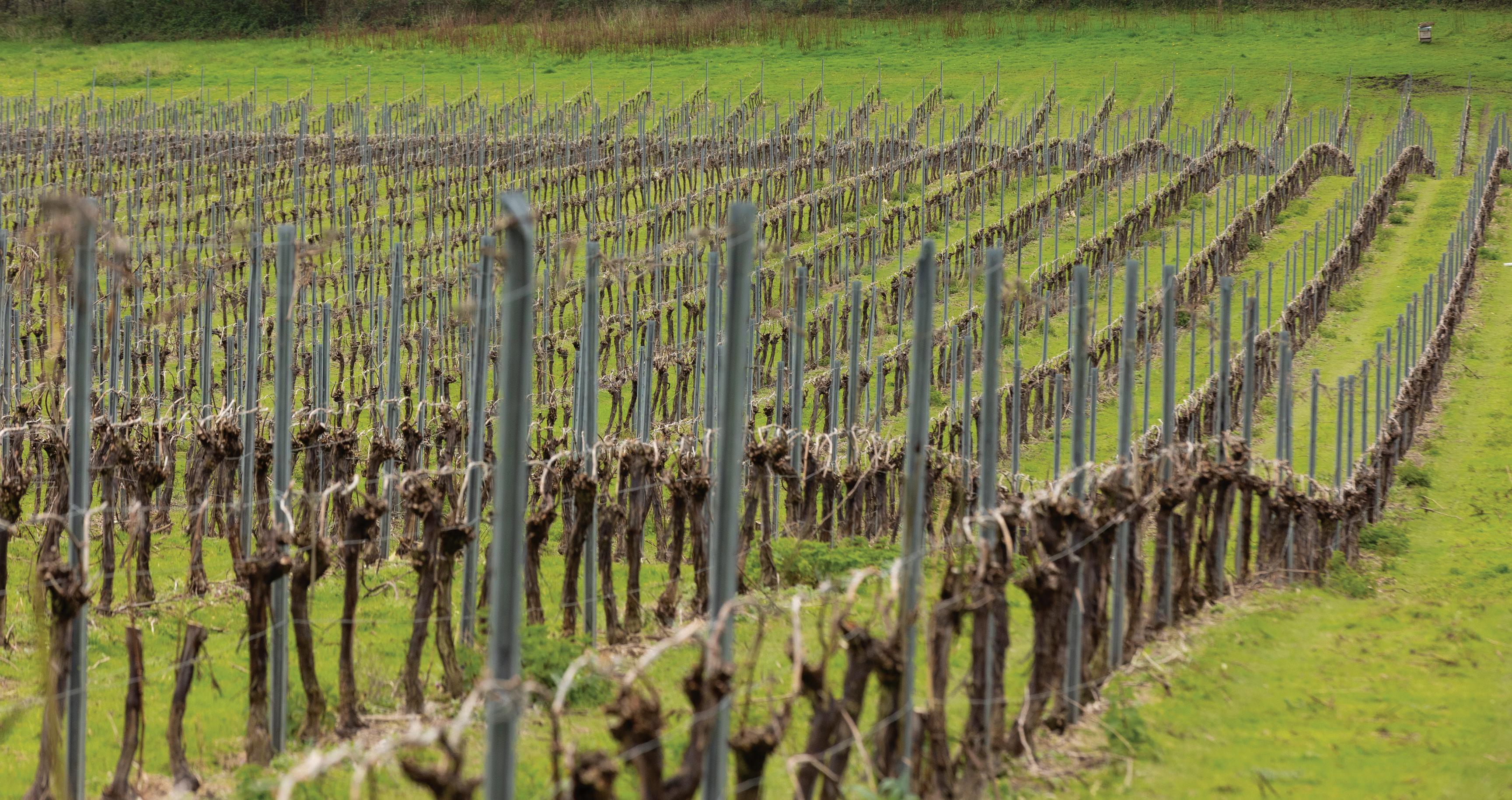
had a record vintage of 220 tonnes in 2023
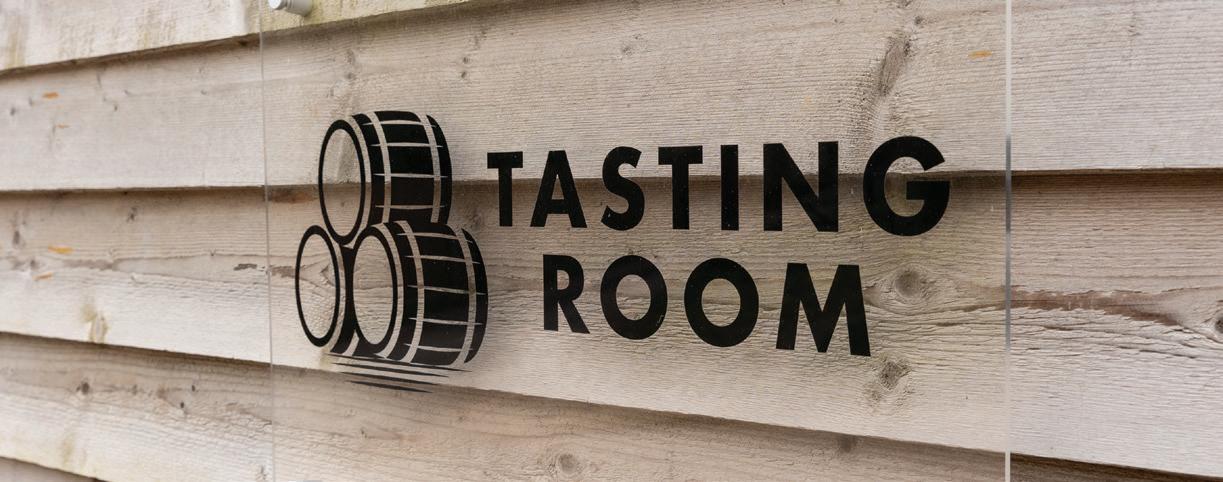
The day of the visit Greyfriars were bottling and Mike explained that the tasting room was not the only project that was completed during lockdown. To increase the space inside the winery a bottling shed was built. “Bottling is not the nicest job,” said Mike. “It is repetitive, noisy and physically hard,” he continued. The new bottling room has given Greyfriars a sense of flexibility which is valued by the whole team. Bottling started in February and will continue through to June.
Greyfriars had a record vintage of 220 tonnes in 2023. The previous record was 2018 with 190 tonnes. Mike reflected on 2018 with mixed emotions. Whilst the yield was exceptionally high the length of the picking season had extended to 25 extremely long days. “By the end of picking everyone had fallen out with each other,” he joked. “Everything was picked by hand and the capacity in the winery meant that we had to stop three times because there was not enough space.” Every season produces a learning experience and Greyfriars experience in 2018 meant that by 2023 the team were ready for the challenges. “We reconfigured the winery so that we had reception tanks with rapid cooling and we expanded the cooling the capacity so we can settle the must faster. The juice has a more organised journey around the winery from pressing, through settling, through fermentation, fining and cold stabilisation.”
Alongside the increased cooling capacity Greyfriars had also increased their tank capacity with help from Core Equipment. “Core have been really good, I know it can be difficult to get people to deliver tanks on time, the problem is because we are a small wine producing country with a later harvest everything gets pushed back so for them to manage that process is great,” said Mike.
There are now three different cooling and heating circuits. “We

didn’t go out and buy 25 more tanks but each year we have tweaked the system, we probably have 160,000 litres of various sizes and this year we bought a second screw capper from Core Equipment to increase our ability to produce still wine,” he added.
Alongside the steel tanks Greyfriars have between 10,000-15,000 litres of old oak barriques. “This is not to add flavour profiles but to give softer mouthfeel and micro-oxygenation which we think is really interesting,” said Mike.
Due to problems caused by Covid-19 in 2021 Greyfriars tried machine picking some of their grapes. This was so successful it has been adopted as part of the harvest regimen every year. Explaining the benefits Mike said: “Firstly you get the grapes quicker, when picking by hand it is lunchtime before a first press load arrives at the winery, with machine harvested fruit it is literally picked and into the press in 20 minutes.




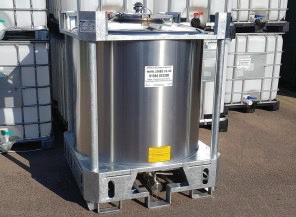
<<


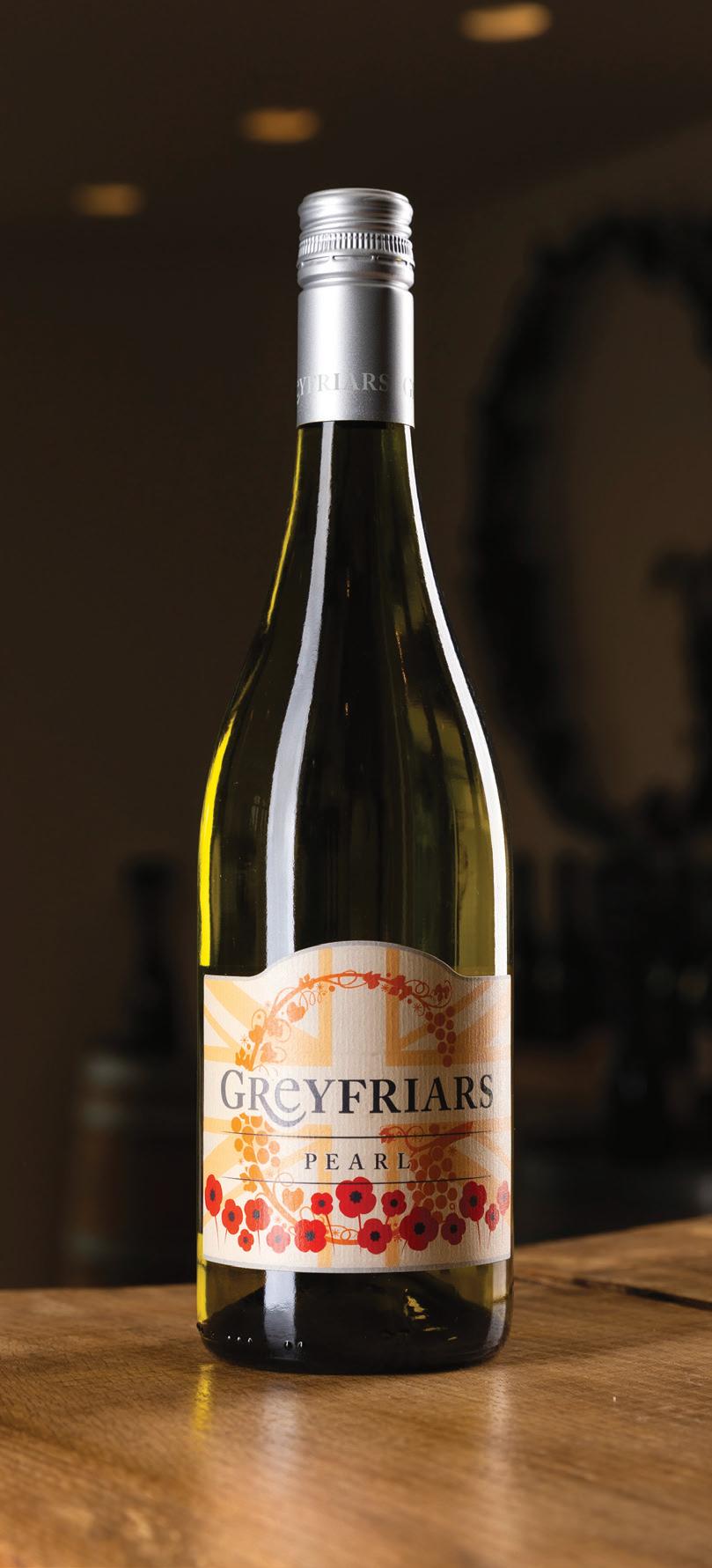



<< We make a large proportion of saignee method rosé so whether you crush and destem in the vineyard or in the winery it doesn’t make any difference to the quality of the wines we produce.” The Willmes presses at Greyfriars are now ready for their twelfth harvest “they are serviced every year by Vigo and are still absolutely perfect,” Mike added.
“Machine picking does mean that the fruit might have to be picked a little bit earlier and you have to be very aware of producing clean fruit,” he added. The vineyard have been very well supported by Julian Searle and Ben Brown of Agrii. “The service is really great and Ben and Julian are so willing to give honest advice about everything, not just chemical purchases,” said Mike.
Not all the fruit is machine harvested and the hand picking is undertaken by volunteers. “We had 350 people over three days for the 2023 harvest,” said Mike with pride. “We send out an invitation and last year we had to shut the list after 12 hours. We don’t expect our volunteers to pick tonnes and tonnes of fruit and we get a food truck in and they have dinner at the end of the few days and everyone gets a commemorative t-shirt. Every year we do a different design.” This
again highlights how Mike and his team are really putting in extra effort at every step to encourage people to get involved and really embrace not only what goes into their food and drink but also the fun side of English Wine. “People are already sending emails asking if we know when picking is going to be. Last year it started to rain at one point and I suggested that people might want to take a break but they were all really keen to carry on,” he added with a laugh.
There are some younger vines such as Pinot Gris and Pinot Blanc which are not mature enough to be machine harvested. The Pinot Gris was planted at Greyfriars in 2012. “I like drinking Pinot Gris and it seemed to be a variety that works well in Britain,” said Mike. It is also suitable for adding to Sparkling wine. In 2015 the first still wines were made and have been made every year since. “If you are only going to make sparkling wine you are limiting yourself to a small percentage of the market.”
In fact 2023 was the only year a sparkling Pinot Gris was produced and the reason for that was the extra volume of fruit allowed some grapes to be dedicated to a sparkling wine. As an experiment 1,000 bottles of sparkling Pinot Gris will be produced. “That is
what excites me about winemaking, the ability to make and sell on an equal basis without the constraints around techniques or varieties we can experiment and we learn sometimes it works and sometimes it doesn’t,” Mike said.
To add to the still wines that can be produced on the warmest part of the site Sauvignon Blanc was planted in 2015. It does not always ripen enough to produce a still wine so Greyfriars tried another experiment. Now one of the trademark wines produced by Greyfriars is a Sparkling Sauvignon Blanc simply labelled SB. “We are the only producers of sparkling Sauvignon Blanc in England,” said Mike with enthusiasm. He admitted that it is very different and therefore will not be to everyone’s taste “a bit like Marmite,” he said laughing but it has been embraced by local stockists and as it brings a different flavour profile it has become popular in cocktails in bars and restaurants. This fits with Mike’s desire to get people talking about English wine. In Europe cocktails are one of the notable growth areas in beverages so including English wine on the ingredients for speciality cocktails is another great way to introduce a growing audience to English wine. <<
“We realised the problem with still wine versus sparkling wine is the variation between vintages. Restaurants are put off by the vintage variation, so we decided to make a blend that we could produce every year it might not be an identical blend but it would have the same characteristics and a similar flavour profile – in essence consistent but not identical.” This led to the production of a Pinot Gris Chardonnay blend in a sufficient quantity that Restaurants and pubs will know they can always have this wine on the menu.
Looking for inspiration for the name of this new creation Mike and the team decided to incorporate some local history into each bottle. “Wanborough Manor (situated near to the vineyard on the Hogs Back) was a spy training centre during WWII. We thought it was interesting that a very high proportion of these spies were women. It was the only place where women served on the front line and very little is known about the S.O.E. division. We name each of our blends after a different female member of the S.O.E. The first wine was named after Noor and released in 2021.”
With a beautiful sense of symmetry, the land on which Greyfriars sits had at one time been part of Wanborough Manor.
A few weeks after the release of Noor, Mike received an email from someone who had

been on the tour. “She said that she had enjoyed the wine tasting and loved the story, she went on to say that her grandmother had been at Wanborough and had trained with Noor and went behind enemy lines and ended up parachuting into a vineyard in Bordeaux.” Unlike so many she returned to the Surrey area and the next release was named Yvonne in her memory. In 2022 just after the release of the wine named in her memory Mike was invited to the unveiling of a blue plaque for Yvonne. The event was for about 70 people including personnel from the French and

Belgian embassies. Mike was asked to bring some of the wine for the reception. At the reception there was also some wine from the village into which Yvonne had parachuted. Mike said: “The French military attaché came up to me and said he had tasted both of the wines and the English wine was much better than the French one.”
The current vintage is named Pearl with such high praise look out for the wine this year which has yet to be named.
In 2019 Pinot Blanc was planted on site and this started to produce in 2022. The blend

now contains about 10-15% Pinot Blanc. So this wine is now a three wine blend.
Looking forward to the wines that are soon to be released Mike said: “2023 was a good year for still wines with low acidity so there will be a still Sauvignon produced. We also held back some Chardonnay from our older plot which we fermented and aged in barrels we produced 1,400 bottles named Goldenrod which is the Saxon name for Guildford. Typically Greyfriars Vineyard wanted to involve the community and so a competition was launched to name this Chardonnay. “We
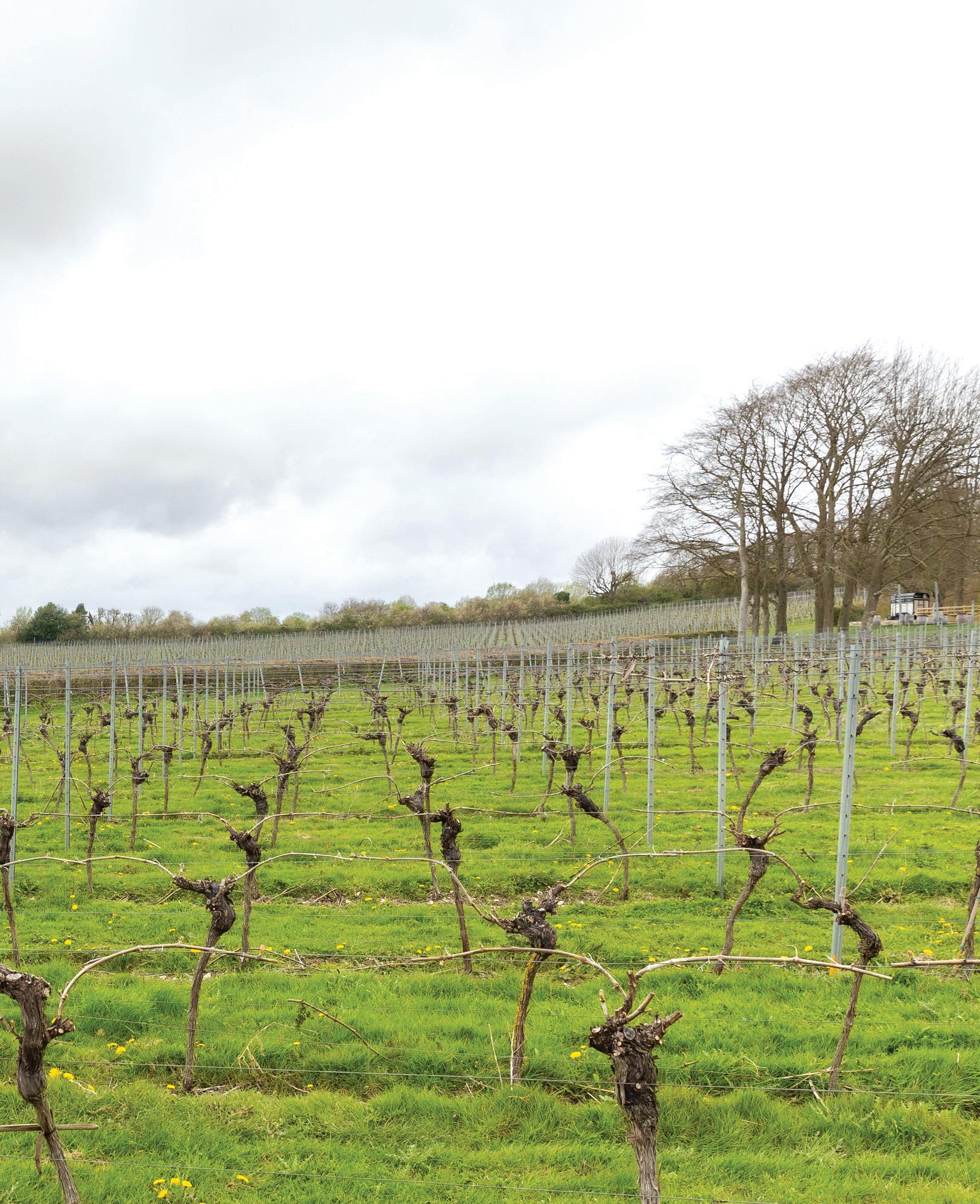
sent the email on a Friday afternoon and by five o’clock we had hundreds of replies,” said Mike. Goldenrod will be released in the next few weeks. Also on the horizon is a single variety Pinot Blanc and a still rosé.
Greyfriars is a place where community values and a sense of fun mix with exceptional talent and a passion for continuous improvement. It is a place where looking forward is as important as celebrating the past and English wine is not something that is produced but rather embraced. Its not what they do its who they are.


VineWorks was founded on the simple premise that quality wine starts on the vine. It’s our aim to help grow the reputation of UK wine, one vine at a time.
The company was started in 2006 by James Dodson while he was studying Viticulture and Oenology at Plumpton College. What began as a small trellising business quickly evolved into one of the UK’s leading viticulture services companies.
Today, VineWorks offer a full range of vineyard support including establishment, vineyard management, vine sales, fruit brokering and an online vineyard shop. With over 300 vineyards established, 4.5 million vines planted, one million posts installed and thousands of tonnes of grapes hand-harvested, our expertise comes from experience.
We are very proud to be one of the major sponsors of the Vineyard & Winery Show 2024. It is our first time stepping up as a major sponsor, having exhibited at the show for many years.
“VineWorks has a long association with Vineyard Magazine having
appeared in every issue with our monthly viticulture advice column –The Vine Post – since the publication started six years ago, so joining the ranks as a major sponsor of the Vineyard & Winery Show felt like a natural step for us”, said James Dodson, CEO and founder of VineWorks.
“As a company, VineWorks has evolved a lot over the years in response to the changing needs of the UK wine industry. We were one of the first to become a licensed vine importer and GLAA-approved labour provider. In addition to establishing and servicing vineyards, we now sell vineyard supplies through our online shop, and are expanding our grape brokering service. The Vineyard Show is a great opportunity for us to catch up with colleagues, promote the full range of our offer, and have face-to-face chats with clients, both old and new,” said Chris Buckley, Business Director of VineWorks.
VineWorks will be exhibiting at the Vineyard & Winery Show. Drop by to meet the team, have your viticulture questions answered, and see vineyard products and equipment up close.

With Jo Cowderoy's diverse background in wine production and David Blake's global vineyard expertise, they lead immersive learning experiences and hands-on mentorship, shaping the future of the industry for students.
I’m thrilled to have returned to teaching at Plumpton College and have the opportunity to share my knowledge to support our wine production students on their journey. I first taught at Plumpton between 2010 and 2015 and it’s so exciting to see the successes of the past students – many now leaders in our industry!
I became interested in viticulture at Rock Lodge Vineyard in Sussex, which was originally planted in the 1960s by my husband David’s family, and is now managed by Plumpton College. After completing my degree in Agriculture, I initially worked as a journalist but loved being in the vines at Rock Lodge. My career so far has been delightfully varied – producing wine in the UK and France, writing and teaching, and I feel very fortunate to have witnessed some of the key milestones in our industry so far.
Jo was one of the lecturers supervising the recent Masters trip to Cava. Students had visits planned for them by Cava DO, each of them themed around key topics: sustainability, indigenous grape varieties, and long aging to name a few. As well as small boutique wineries, students visited Freixenet, the largest exporter of Cava and largest producer of traditional method sparkling wine worldwide.
Selling wine at a prestigious London wine merchant offered me the privilege of visiting many great wineries throughout Europe. I left each trip with an increasing fascination about the subtle intricacies of making wine and tending vines. In 2008 I decided to study for a bachelor’s degree in Viticulture and Oenology at Plumpton College. Studying the chemistry of wine, vine biology, and the curious dance of
micro-organisms proved the maxim, “the more you know, the more you know there is to know.”
After vintages around the world; in Spain, NZ, Napa, Mexico, and the South of France, I moved to Burgundy. I worked at a renowned winery in Chablis as an assistant winemaker, then in their vineyard team. After some years I moved to a post in one of Saint-Aubin’s top producers, and then as a one-man winemaker/vineyard team at a bio-dynamic vineyard near Mercurey. Finally, in 2024 I have returned "home" to become Vineyard Manager and Lecturer at Plumpton College.
Joe and Harry have been working with David in the vineyard this season. Harry said: “Working in the vineyard alongside David has been an excellent experience, as someone who has completed the degree and has worked in such prestigious regions, his advice and tuition has been invaluable to me and my future career in the industry’’. Joe added: "When you meet David, you can tell he has a wealth of experience informing every decision. His charm and charisma ensure that everything is done with a smile, and a distant tune being whistled or hummed makes him easy to find amongst the vines. He is a great mentor who I look forward to seeing every day I'm at Rock Lodge vineyard."


Business


Vine nutrition needs close attention ahead of the crucial flowering period, following the exceptionally wet winter and start to spring. Hutchinsons agronomists Tim Ferris and Will Robinson explain more.
Many soils have seen a large amount of nutrient leaching over recent months, particularly of water-soluble nutrients, such as nitrogen, boron and sulphur, but availability of other macro and micro nutrients could have been affected too.
In severe situations, prolonged waterlogging can impact root development, especially in newly planted vines, and reduce the activity of soil microbes involved in processes such as the breakdown of organic matter and nitrogen utilisation. So, as growth and nutritional demands increase, it is vital that any potential deficiencies or rooting issues are identified and addressed early.
Regular soil testing provides a useful indicator of overall nutrient status, but this should be supported with petiole analysis at early flowering to build a more complete picture, and crucially, highlight any potential deficiencies in time to respond. When petiole sampling at flowering, remember to take the petiole from the leaf opposite the lowest bunch position on a shoot, selecting representative vines of the same variety.
Although petiole analysis helps fine-tune nutritional strategies through the main growing and bunch development period, it may also be beneficial to give vines an early boost before flowering starts to avoid any deficiencies compromising flowering and pollination.
A slow-release N,P,K fertiliser, such as pelletised poultry manure, may be a
good option, while biostimulants based on concentrated seaweed extracts (e.g. Maxicrop, Kelpak) can also help stimulate early development, and contain some useful nutrients, such as nitrogen, phosphate, and potassium. The first application is typically from the two to three leaves unfolded stage, and may be supported with additional boron or calcium.
Boron is key to plant reproduction, giving improved flowering and fruit set, so levels must be sufficient before flowering starts. Calcium is vital for cell structure, so it is equally important to avoid any deficiencies when vines are putting on large amounts of growth.
Sulphur plays a central role in amino acid protein synthesis, so targeted granular application may be necessary to bring the soil back into balance after such a wet winter. In many cases, sulphur may be applied with magnesium (e.g. granulated kieserite), a key nutrient for chlorophyll production, and one that is prone to deficiency, especially on sandy or acidic soils.
Grapevines do not have a huge requirement for nitrogen, however it is a crucial nutrient for many plant functions and if excessive leaching, denitrification, or low soil levels cause a deficiency, this will lead to stunted growth and reduced yield potential. Deficiency is usually easy to identify, characterised by a yellowing of entire leaves, often older ones first. This is in contrast to iron deficiency, which tends to affect younger leaves and causes yellowing between leaf veins.
Additional nitrogen applications should be

carefully targeted to required areas only, to avoid stimulating excessive vegetative growth on vines that do not require additional N.
If petiole analysis reveals an urgent need for certain nutrients, foliar nutrition in metalosate form has been shown to be a quick way to get nutrients into plants. Mineral nutrients are chelated with amino acids, which protects them from adverse interactions and improves absorption and translocation.
Most foliar nutrients can generally be included within the tank mix when applying other plant protection products, although, as always, check label recommendations carefully. In contrast to foliar nutrients, uptake of soil-applied fertilisers via roots inevitably takes longer, and is subject to many more external factors. However, it does allow larger quantities of macronutrients to be applied than is possible through the leaf, so is a good option for building a solid base of soil nutrition, depending on the specific site requirements.
Given how wet the winter and early spring has been, it is a good time to mark out and record any areas of the vineyard that have suffered waterlogging, so remedial measures can be planned for later in the season.
Actions may involve subsoiling or other drainage improvements, or the establishment of cover crop mixes down alleyways to help manage soil moisture and bring other soil or biodiversity benefits.





Joel, was born and raised on a family vineyard in South Africa, where he earned a BSc in Viticulture & Pomology from Stellenbosch University. Intrigued by the UK wine industry, he moved to the UK in 2011 and began his UK journey managing an organic vineyard in Hampshire. Joel has since provided precision vineyard management across the sector and consulted to some of the top UK vineyards.
What does achieving optimum vineyard balance mean to you?
One of the favourite elements of my role at Vinescapes is helping clients achieve optimum balance in their vineyards, especially when we start, at pre-planting stage. Getting it right from day one by using our VineMap tool to accurately map and project a field's climatics and have a good look at the soil life fundamentals before deciding on the next steps. Selecting appropriate clones and rootstocks is always an interesting and exciting conversation with clients, where we can marry up the sites capabilities with their wine style goals. Once the vines are in the ground, it's always a pleasure to provide precision vineyard management to clients so we can continue to bring the vines to fruition.
What gets you excited about a day in the vineyard?
Managing a vineyard is never predictable; each season, field, and vine presents unique challenges, which keeps it both interesting and exciting. I'm really enthusiastic about how rapidly we are realising true soil health and how it can affect vine health and wine quality. I'm passionate about pruningreading a vine's history, carefully sculpting it to optimise yields and quality with minimal damage, is incredibly fulfilling.


How do you approach soil and vine health?
We have certainly noticed that sites where we have achieved great soil health are seeing much better vine health. We start by looking closely at the soil structure, then performing various soil tests. We then start the journey of recovery straight away which can involve things like introducing specialised cover crops, reducing tractor passes, less mowing, re-evaluating machinery choices etc.
What does vine balance mean to you?
A truly balanced vine produces an optimum crop load each season, without major peaks and troughs and always meets the desired quality parameters, no matter the weather! A balanced vine has all the desired ratios of physical properties such as roots to shoots, old wood to annual wood, fruit to pruning weights, leaf area to fruit weight and so on. With every site being unique, the key to delivering great grapes is getting to know your site and your vines and discovering exactly what those optimum ratios are, then aiming to manipulate your vines with those targets in mind.
How do Vinescapes support UK vineyards?
Our key strength is our understanding of sustainability in every sense of the word.
Ensuring each vineyard we plant and manage is not only sustainable from an environmental perspective, but also financial. We go to great lengths to help our clients create sound wine businesses with vineyards planted in optimum locations to deliver the best quality wine.
I’m extremely proud of the expert team we have at Vinescapes and I’m excited to continue our support of UK viticulture, as it develops over the coming years. If you would like more information in relation to Vinescapes precision vineyard management, vineyard establishment or our other services, please get in touch.








This month, I caught up with John Buchan, one of the UK wine industry’s most experienced and respected agronomists, to pick his brain about vine nutrition.
John, how did you get started in agronomy?
After leaving agricultural college, I was a farm manager for 20 years working with livestock and arable, and then worked for an American specialist nutritional company in the UK. So, I have always been involved in agronomy.
How did you get involved with vineyards?
I was asked to look at a sick vine whilst exhibiting at the Royal Show, which ended up with me visiting the vineyard in question. It all started from there, which was 23 years ago and many vineyards since.
Why not enjoy a well earned retirement?
Why should I retire when growers are finally paying attention to the importance of understanding the soil’s requirements? My work is not done yet with more to understand and pass on.
John Buchan
What are the key considerations early in the growing season?
The secret to early establishment and healthy growth starts with the application of a balanced fertiliser formulated in response to previous soil and tissue analysis results. Always replace those nutrients removed by the previous crop and redress any underlying deficiencies. The application of a high rate sulphur/copper mix before bud burst can reduce bud mite damage, then an application of a copper/boron/molybdenum complex will maximise embryo formation resulting in optimum fruitful buds. Under vine weed control, pre-bud burst should be done to reduce competition for nutrients to the vines.
What key nutrients are often overlooked when growing grapes?
It is essential to understand the vines' requirements at each key growth stage. This will have a significant effect on the ability of the vine to produce optimum healthy disease-resistant growth, both for the leaf area and, subsequently, berry numbers and bunch fill. Any nutrients applied must be done before each growth stage, ideally 10 to 14 days in advance, to optimise availability when reaching the specific growth stage. Boron/molybdenum complex foliar application has a well-documented response to increasing pollen production and viability, thus optimising flowering and fruit set. It must be accepted that if any nutrient is in deficiency the optimum production will be compromised. Therefore, it is essential that soil samples be taken every three years, and tissue or petiole samples taken pre-flowering every season to enable any fine-tuning of the nutrient programme.
With your crystal ball where do you see the future of agronomy heading?
The future is bright for agronomy as we aim to reduce our reliance on agrochemicals and chemical fertilisers by re-balancing our soils, both nutritionally and physically. This is done by creating well-drained aerobic

and balanced organic soils, which will allow optimum nutrient retention without compromising availability. This will help create sustainable soils for the long-term future of our industry.
What has been your hardest harvest for disease?
The most challenging year for me was 2012 when it rained throughout the growing season. This made spraying almost impossible resulting in a massive increase in Phomopsis on the canes, and powdery and downy mildew and botrytis having a field day. However, those who persisted in taking any and every opportunity to spray did manage a crop.
How do you get the best return on investment from a spray programme?
Spray programmes, however good, can only be successful if the sprayer and operator are up to the job. It is essential for the sprayer to be fully functional and correctly calibrated for the products being applied. The operator must also hold a current certificate of competency relating to the sprayer type. It is essential that neither over nor under-application is done, as this will build up resistance to the efficacy of the products applied. Spray programmes must take into account harvest intervals, the number of applications per product, the use of differing actives relating to the specific disease, and targeting spraying of the fruit zone only in certain cases. Correctly targeted growth stages for both fungicides and nutrients will maximise the potential for healthy, balanced production. Correct canopy management can be more than half the battle. Maximise airflow – you should be able to see through three rows. Air is free, so use it!

Researchers at the University of Reading’s School of Agriculture, Policy and Development have investigated the wine characteristic “minerality”.
Minerality is a relatively new term which has become widely used by wine professionals and consumers over the last quarter century, especially for highquality cool-region still white wines. It is poorly defined in sensory terms, however, and its origin is difficult to pin down. Many producers claim it arises from the vineyard’s geology and soils, but this idea has largely been discredited by Alex Maltman, a geologist at Aberystwyth University, and several other researchers. Taking Chablis Premier Cru as an example of
a Chardonnay wine well-known for its mineral flavours, Alex Biss and Richard Ellis analysed thousands of tasting notes (from 2003 to 2022) on CellarTracker, a crowd-sourced database of wine-tasting notes. They combined this with weather, topography, and soil data for the Chablis area.
They found that use of the descriptive term minerality in Chablis Premier Cru tasting notes declined markedly over these 20 years, whether analysed by vintage or tasting year. In contrast, use of descriptors for acidity, orchard fruit, stone fruit, and salinity all increased over


the same period (Figure 1). They also found that the use of the term minerality was mainly associated with stony perceptions (chalky, flinty, stony) and secondarily with saline and seashell perceptions.
In terms of the production environment, their analyses revealed that minerality was negatively correlated with both growing season temperature and sunshine hours, and negatively with percentage vineyard area facing South or South-West, but not with soil type. Hence, soils and geology appear not to affect minerality of Chablis wine, in agreement with Alex Maltman. On the other hand, minerality is reported less for wines from warmer and sunnier sites and growing seasons when tropical and/or stone fruit sensations are to the fore.
The researchers suggest that the decline in the use of the term minerality by consumers was probably due to three factors: (i) the warming of growing season temperature due to climate change, (ii) a decline in the popularity of the term, and (iii) the increasing use of alternative descriptive terms, such as saline (where appropriate), with minerality retained for “stony” perceptions.
One implication of the study for emerging wine regions such as the UK is that minerality is largely determined by weather and microclimate, not by soils or geology. As such, high minerality in wine, as often associated with Chablis, is possible anywhere with the right climate.

 Rüdesheimer Roseneck
Rüdesheimer Roseneck
It was Monday 23 June 1975, and I was being introduced to the people who would be my workmates for the next twelve months. No doubt the chef (the boss) had told them that they had a new praktikant starting that morning and I feel sure they would have asked ‘What nationality? South African, Italian, USA, Dutch?’ –they had seen a fair few over the years. I am sure when he said ‘English’ there was a general groan along the lines of ‘what do they know about vineyards?’ and of course they were quite right – I knew practically next to nothing. We soon piled into an old green van which took us to and from the different vineyards that made up the 170 ha Schönborn estate which stretched for over 60km
from Lorch in the west to Hochheim in the east. That morning we were heading for one of their steepest (and warmest) sites, the Rüdesheimer Roseneck.
After around 30 minutes we arrived at the vineyard and unloaded our meagre equipment, a few very basic steel hoes, and after a quick pause for some water, Angelo, the 5’ nothing Sicilian who was the foreman of the gang, handed me a hoe and said what I assumed to mean ‘follow me’ as he set off up the slope. The slopes here are truly heroic, almost at 45° in places, and there is only one way to work if
For anyone contemplating planting and establishing a vineyard in the UK, and for those already growing vines on a small scale who perhaps wish to expand their vineyards and improve their winegrowing skills, it will be invaluable. It will also be of interest to students of viticulture. Wine Growing in Great Britain covers not only the viticultural tasks involved, but also, uniquely, the finances of UK wine growing: land costs, vineyard establishment and management costs and the income from both grape sales and wine sales.
Available from: Amazon and World of Books

you are on foot, top to bottom. The work was hard and repetitive –clearing the weeds away from the vines as gravity helped us down the slope – with a quick stop each time we reached the bottom for a drink and a short pause, before trudging back to the top for the next row. The work seemed to go on forever, and boy, was I glad when 11.30 am came around and we could head back to the yard for lunch.
The work amongst the vines followed the seasons as it always has and always will. The year started with pruning in early December and lasted until mid-March. With pruning and tying down finished, there was a chance to attend to the trellising, replacing broken wooden posts, tightening up wires, and generally getting the vineyards ready for the coming season. As the season progressed there were buds to be rubbed off, followed by tender shoots to be tucked in and made secure. In the summer as the shoots lengthened and grapes appeared, there was more tucking in, topping canes and some leaf removal in the better vineyards. As harvest approached, the whole workforce readied themselves for picking and winemaking. Presses were exhumed from their winter quarters, tanks and barrels were cleaned and readied, and picking buckets and grape ‘hods’ were dusted off and stacked in the yard. The years I was in Germany –1975 and 1976 – were both hot years with early harvests and the weather was pretty kind throughout the picking weeks. In fact I only picked grapes for the first morning, wangling a place in the press-house, where I loaded and unloaded one of the Willmes airbag presses, keeping the place as clean and tidy as possible, and generally being useful around the winery – a true cellar rat!
One of the reasons I was keen to work in the Rheingau was its proximity to Geisenheim, arguably the premier wine school in Germany. Whilst its winemaking department was well-known, it was its vine-breeding section for which it was famous. It was the birthplace of Müller-Thurgau, then Germany’s most widely planted variety and also the variety that bulked up most of the Liebfraumilch that was then being made, but the school was also proud of its work on rootstocks, Riesling, and new varieties. The vinebreeding department was headed by Professor Helmut Becker, who enthusiastically welcomed me and soon set my mind at rest when I asked him about studying there. ‘No problem’ he said in his excellent (if American-accented) English ‘just go to the main reception and ask for a gasthörer [observer] ticket’. As simple as that. 50 deutschmarks (about £20) later I was the proud owner of a guest ticket which allowed me to attend any lecture I wanted, use the facilities – library, canteen, gym etc – and take part in events and outings.
Professor Becker was amazing, a real superstar in the world of vine breeding. He would speak to me in almost perfect English, perfect grammatically, but peppered with salty words that my mother would certainly not have approved of. I asked him once “where did you learn this slang?” and he told me the story. Aged 16, he was press-ganged into the German army in the final year of the war, and his father told him “the first time you see an American soldier – surrender.” This he did and was shipped off to a prisoner-of-war camp in Florida where he learnt the finer points of colloquial English by a sergeant-major who basically swore at his charges from dawn to dusk.
Once I had finished my 12 months at Schönborns, I spent as much time as I possibly could, attending classes, sitting in the library, going on trips and visits and reading as much as I could about vineyard establishment. As the long, hot summer of 1976 ended and we returned to England for my sister’s wedding, my father-in-law told me that the 71 ha (175 acre) hop, fruit and pasture farm which adjoined his estate in Tenterden, Kent (today the home of Chapel Down) was on the market, and he intended to buy it.
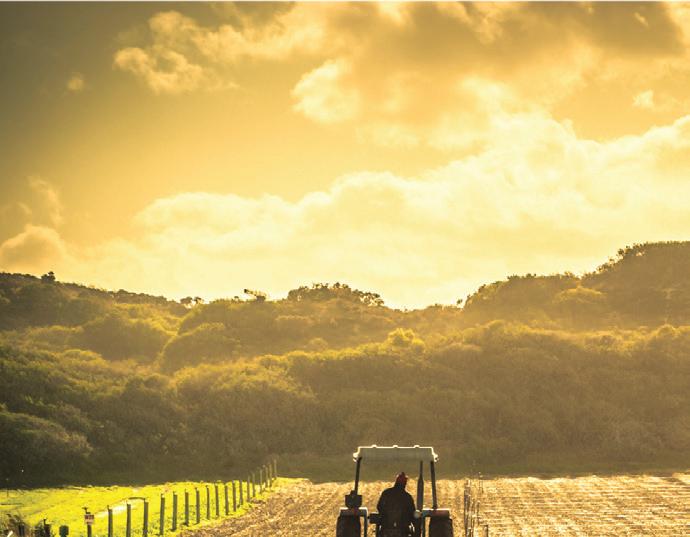




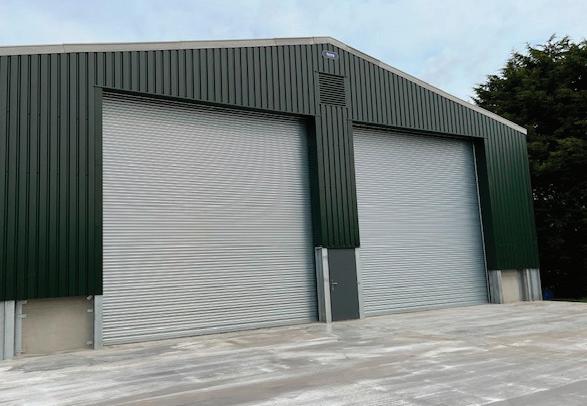

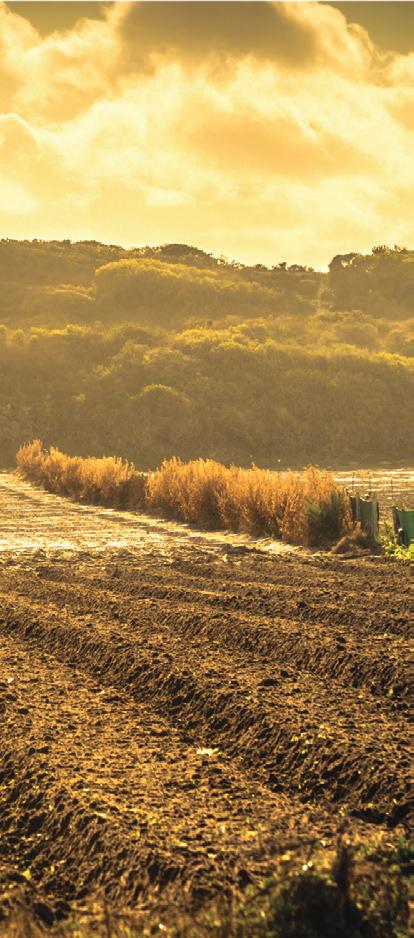




Anticipating that I might be interested in some of the land he had already had the land surveyed by a soil scientist called Alan Furneaux. Alan, and his father Basil before him, had surveyed almost every fruit farm in Kent and Sussex so he knew what he was talking about. He had written in his report: “It is my understanding that some of this land is to be used to plant vines. I cannot think of a finer site in the whole of the south of England for a vineyard.” With this ringing endorsement, we told my father-in-law that we would love to farm it, and set about deciding what varieties to plant, how much and in which fields.
We liked the look of the farm buildings which we thought would make a good winery, storage sheds and farm shop. With the land no higher than 60m above sea level, free-draining sandy soil and some sheltered south-facing slopes, we had high hopes for our new enterprise.
After all this excitement it was time to go back to Germany where for the next five months, I busied myself in more studying and more visiting vineyards, plus the task of selecting which varieties to plant. By now, Professor Becker and I knew each other well, and he was most generous with his time. He had already been in contact with Kenneth McAlpine and together with Professor Kiefer, head of Geisenheim’s viticulture school, had visited Lamberhurst and been involved with their site and variety selection. I thought the best way of going about this was to write down a list of all the possible varieties that I had
been collecting data on and then discuss them with Professor Becker. I showed him the list one afternoon after a lecture, and he said: “I’m busy now, come back on Thursday” which I duly did.
“Lets go down to the cellar,” he said and we descended two floors down to the lower cellar where tastings always took place. There, stretched out on the long oak table, was a bottle of wine from every variety on my list, about 35 in total! We then spent the next two hours tasting every one, me making notes as we went, and Professor Becker making useful comments.
Of course, then as now, selecting varieties is fraught with danger. Do you plant the tried and tested varieties that everyone else is using, or take a chance and choose something that nobody else is using?
Of course in those days, there were three varieties that almost all English vineyards were growing: Müller-Thurgau, Seyval blanc and Reichensteiner. They had to be in the mix. I chose a Geisenheim special called Gutenborner which only one other grower in GB had planted (Carr Taylor). I tasted and liked several other varieties and decided to plant a ‘trial vineyard’ with 25 vines of the other ‘major’ varieties: Schönburger, Bacchus, Ortega, Huxel, Madeleine x Angevine and Kerner – plus another 10-15 varieties in smaller numbers. With the vines chosen and ordered, we were well on our way to planting what would become Tenterden Vineyards in April 1977.

Have you got bulk wine to sell?
• Free to look
• Request a sample
• Post your own wines for sale for £10











Vivai Cooperativi Rauscedo, based in the small village of Rauscedo in Italy was established in 1933 and for over 90 years has been striving to help growers achieve the best results from their vineyards.
Vivai invited Vineyard Magazine to visit their headquarters to experience first-hand the process of grafting and the continuing research at this nursery and centre of viticultural science.
Situated about an hour from the beautiful city of Venice this small area of countryside is just as internationally significant within the viticultural community as its more famous neighbour is for its canals, architecture and colourful glass production.
Every year in excess of 80 million vines are produced by the Vivai Cooperativi Rauscedo (VCR) and shipped to countries worldwide. It is quite astounding to realise that VCR clones are used by growers on every continent.
Walking up to the state of the art facilities, built in 2019 to house new laboratories, there is a sense of Alice in Wonderland. By that I mean that the scale of the operation in Rauscedo has so many divisions and covers such a vast area that it is possible to lose yourself and to have that childhood feeling of everything seeming bigger. Yet the organisation is still very much connected to its beginnings.
VCR started all those decades ago with a commitment to improve
the fortunes of the growers in a small village that had suffered from economic depression. With the help of an Italian cavalry captain during WWI, whose profession was actually a university Professor of Agriculture (so legend has it), the local farmers were able to perfect their techniques and work together to start distributing their grafted vines.
The black and white pictures of these early vines being delivered by horse and cart or indeed bicycles feature prominently in the modern facilities that now include over 100,000m3 of refrigerated storage. The growth of VCR has stemmed from the continual focus on helping growers to get the very best from the vines in their soil and subsequently their vineyard.
VCR was the first commercial company in Italy to make clone selection. In 1969 the first R-clones were released (the R standing for Rauscedo, the name of the area). “This was done to achieve a plant that would allow the prediction of how a vineyard would behave on your land,” said Dr Elisa De Luca, Head of the Research Centre. The development of new clones has continued to gather momentum through the years and VCR now have 500 clones on the Italian National


Catalogue which translates to 30% of the whole.
“To do this you have to find the differences within the varieties, for example Chardonnay there is not one type of Chardonnay, you have the one with the big bunch, the one with the small bunch, the one with high productivity and so on…” Dr De Luca explained.
It is clear that the starting point for everything at VCR has always been and will always be plant health. On touring the site there are mother vines that sit behind biosecurity and decontamination measures that are reminiscent of a Hollywood movie.
Dr De Luca commented: “At the very beginning we undertook visual inspections because this was the only way that you could determine if the plant was healthy, you take this single plant and multiply it and create your evaluation field and you start to collect the grapes and make micro vinification, you study the productivity and everything you can think of to find the potential of your clonal selection.” Over the decades scientific analysis has been developed and applied to the process so that VCR ensure that every clone is not only achieving what the customer wants and expects but that it is disease free. “Now we can check our plant through a PCR test to find even really small particles of virus,” she explained. (VCR also make use of an enzyme-linked immunosorbent

assay test which is known as the ELISA test which was first described by various scientists in the early 1970’s). “The PCR test amplifies the amount of virus to ensure that what may not have been detectable becomes detectable just like Covid-19,” she said. Some of the viruses that have been detected and screened out of clones over the years would include GVA. “This requires the bark to be scorched in order for detection to be possible, or leaf roll 1,2 or 3 because the symptoms are not always visually strong,” added Dr De Luca.
Describing the rigorous testing that the clones undergo before they reach the market Dr De Luca explained that there is also a biological test that lasts three years. A selection is made and then this material is grafted to indicator varieties which will mean that any virus that is present but not detected by a laboratory test will manifest itself over the next three years.
Following this biological testing period there is an evaluation period which also allows the collection of data sets relating to every part of the vines life and production cycle including the maturity curve. The clone selection process takes more than 12 years for a clone to come to the market. The amount of work that goes into the development of clones is staggering but underlines the importance of vines to every vineyard.



Throughout the lifetime of the vineyard there will be ongoing decisions about growing systems, trellising, pruning, canopy management, soil structure, inputs, fruit hang time… but fundamentally the vines that are planted are going to be part of the vineyard for its entire lifetime.
“Our job is to give the most clean clone as possible to the customer. We are always following the requests of the customers,” said Dr Nicola Morittu who is part of the Export Division of VCR.
Providing the best service to customers is an ongoing process and has seen VCR collaborate with international groups regarding soil micro biology and micro biota working with partners from the University of Udine and the University of Milan, a group from Stellenbosch, The National Research Council of Italy and a group from Spain.
I ask about current market demands. “This is one of the most difficult questions and we ask ourselves this question daily,” said Dr De Luca. “The new generation of growers appreciate new flavour profiles and lower alcohol productions. The other tendency is the PIWI varieties that reduce spray programmes and are centred around ecological health.
“In Italy we are recognised for our production and our terroir and there is a conflict between the older growers and the younger growers so they are moving towards PIWI varieties but their market has been based on the known and well established varieties so we are at present at a crossroads,” she continued.
There is a striking difference to the English and Welsh wine industry where tradition does not stifle the wine industry and throughout the visit to VCR this lack of constraint is mentioned by expert after expert as something of incredible value to the English and Welsh wine industry.
“In our opinion in the UK you are luckier than our country because it is a new market for vineyards and wine production and wine makers and you have less rules and peoples minds will be more open to accept a new style of viticulture,” said Dr Yuri Zambon Technical-Commercial Director at VCR.
“A decade ago people would drink wine with their meal but now the situation has changed and people drink before or after a meal, people ask for sparkling wine or lower alcohol wine also there is the growth of wine in cocktails,” he added.
“Countries such as England and Wales should be able to adapt to the current market trends with greater speed and what was a limiting factor such as naturally lower alcohol should be embraced as an opportunity. Less cellar management and manipulation needed to achieve these wine styles means greater sustainability for these wines. Controlling sugar accumulation in the grapes in countries like Italy is becoming more difficult year on year as the climate changes,” he continued.
On the topic of difficulties facing the viticulture industry Dr Zambon pointed out that the whole world is conscious of the need to become more sustainable but that is more than simply reducing inputs, water usage, fuel consumption etzc. “We also need to reply to problems of climate change or new pathogens that have arrived in Europe.”
Dr De Luca gave the example of Xylella Fastidiosa (the arrival of this disease in Europe caused DEFRA to release legislation in 2021 to try and prevent its arrival in the UK and to issue regulations regarding containment should an outbreak be detected). “Also we need to address the new strains of powdery and downy mildew that are growing stronger than they were 10 years ago,” said Dr Zambon.



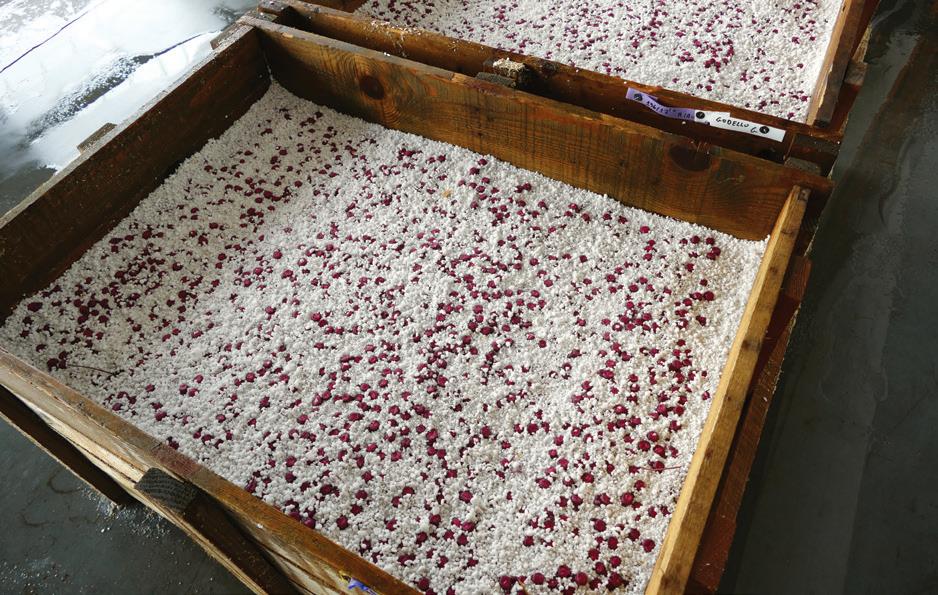

“We are creating PIWI varieties that are similar to the traditional ones. When we cross two parents we also select the offspring that is similar to the traditional varieties so only the sons that have inherited the good quality of both parents are selected,” said Dr De Luca.
“You are not so hampered by tradition so you have plenty of possibilities to find varieties that are adapted to the UK climate it is just a matter of testing, tasting and trying different possibilities,” she added.
It is when describing this process that Dr De Luca really shows her passion for the work that the research centre does. She continued: “It can be difficult to do this because we have to discard many sons that may show interesting qualities but are not similar to the parents. It can be quite a painful process but we want tradition with innovation.” The numbers really highlight the selection process for example in 2023 there were 50,000 seeds that started the process but only 2,000 of these made it through the tests to show their increased disease resistant qualities and from those only a few hundred will make it to the market.
“We are creating resistant varieties that have 93%-94% of the Vitis Vinifera genome, so we are achieving a good oenological result,” added Dr Zambon.
If it takes 12 years for a clone to make it to the market it takes more than 20 years for a new variety to make it to the market in Italy.
At the time Vineyard magazine visited VCR they were in the process of grafting vines that would be available for 2025. This explains why sourcing vines requires a significant amount of planning on the part of those placing orders. The need for advance planning will be even more pronounced if a specialist order is required.
The timing of the visit led to an in depth look at the grafting process and a discussion not just about clones but also rootstocks. Grafting was necessitated by the phylloxera epidemic that swept across Europe and Dr Morittu explained: “85% of the world uses four to five rootstocks that were developed between 1896-1903 so we are <<



working with something that is over 100 years old.” In those 100 years there have been changing climate and soil conditions and whilst traditional rootstocks are still widely successful new rootstocks could provide solutions to certain new problems such as drought and salinity.

<< independently but collectively to produce the millions of grafted vines every year. Some of these produce vines with specialist graft combinations which will involve greater risk of graft failure and some will produce vines that are safer options. Dr De Luca quoted Fercal as one of the more difficult rootsocks where the graft success rate can be 60% so the growers who produce these grafts are paid a premium.
“Rootstocks are even more difficult to work with because the first thing they must be is resistant to phylloxera and also to nematodes and they must also prevent the transmission of GFLV,” said Dr De Luca. Rootstocks also have to be compatible with the clones and have to be suitable for a massive variety of soil types. With 496 varieties, 480 original VCR® clones and 14 exclusive resistant varieties alongside four rootstocks M it is possible for VCR to provide over 4,000 grafting combinations.
The operation in Rauscedo is a cooperative and there are hundreds of growers that work
As the growers are free to choose what they would like to produce this system ensures that there is a fair playing field for the members of the cooperative. One other area that ensures a fair playing field is the way the grafted vines are checked.
The growers check the grafted vines themselves and then the grafted vines are presented to VCR where they will be checked again to ensure quality. As an independent step a third party will also check the vines but this

check is performed blind without knowledge of where the vines come from thus ensuring total honesty throughout the process.
Traditionally the grafting technique is the Omega graft named because of the shape that the graft forms but VCR also have developed a machine that is exclusively available for purchase by members that utilises a Celerina technique where a greater percentage of each part of the graft comes into contact. This increases the probability of grafting success. Also increasing the grafting success is the care that is taken to ensure the rootstock and scion are compatible in diameter. “It is not millimetres it is microns of difference that can mean the failure of a graft,” said Dr Morittu.
The grafted vines then undergo what is known as the forcing period. This takes about two weeks in a temperature of 36°C and at 40% humidity.






Sauvignon Kretos
This early ripening variety made as a sparkling wine won a medal and scored 98/100 at the PIWI wine awards 2023
Soreli
This resistant variety has Sauvignonasse as a parent and this flavour profile has transferred. This variety has proved popular in plantings in Sweden.
Cabernet Eidos
Resistant Cabernet Sauvignon which can reach a depth that would not usually be achieved in the Friuli region which is closer in climate to Germany than to southern Italy.

<< The successfully grafted vines are eventually single planted in the 1200 hectares of nursery space available to VCR. This massive area of nursery is systematically checked “those that are responsible for these checks walk the equivalent of 1.5 times around the earth every season,” said Dr Morittu with a smile. “That must require a very decent pair of work boots,” was my cheeky reply.
VCR go to extraordinary lengths to ensure that those who plant vineyards with their vines are going to get the results that they want. The winery and tasting rooms are simply fantastic.
Some of the equipment in the cellar is created specifically for VCR and will not be found anywhere else. Making wine from grapes is totally different at VCR Dr Morittu explained: “What is our job in the cellar

here at VCR? The job of the winemaker is to translate the clone of the grapes into wine. The winemakers do not put their fingerprint on the wine. Normally it is the winemakers job to bring their unique talent to the process but here that is not their job. The winemakers job is to keep the wines as pure as possible.”
It is possible for VCR to produce 900 micro vinifications every year. They have 25, 50 and 125 litre tanks. Even then there are not enough tanks to accommodate all the clonal selections so there are an additional 500 nano vinifications made each season. Nano vinifications can be as small as 0.25 litres of a wine. Technically these wines don’t even have names yet, they are coded by numbers and names are given purely as a helpful prompt to those working in the cellars. Everything is photographically recorded as well as having all data taken so each of
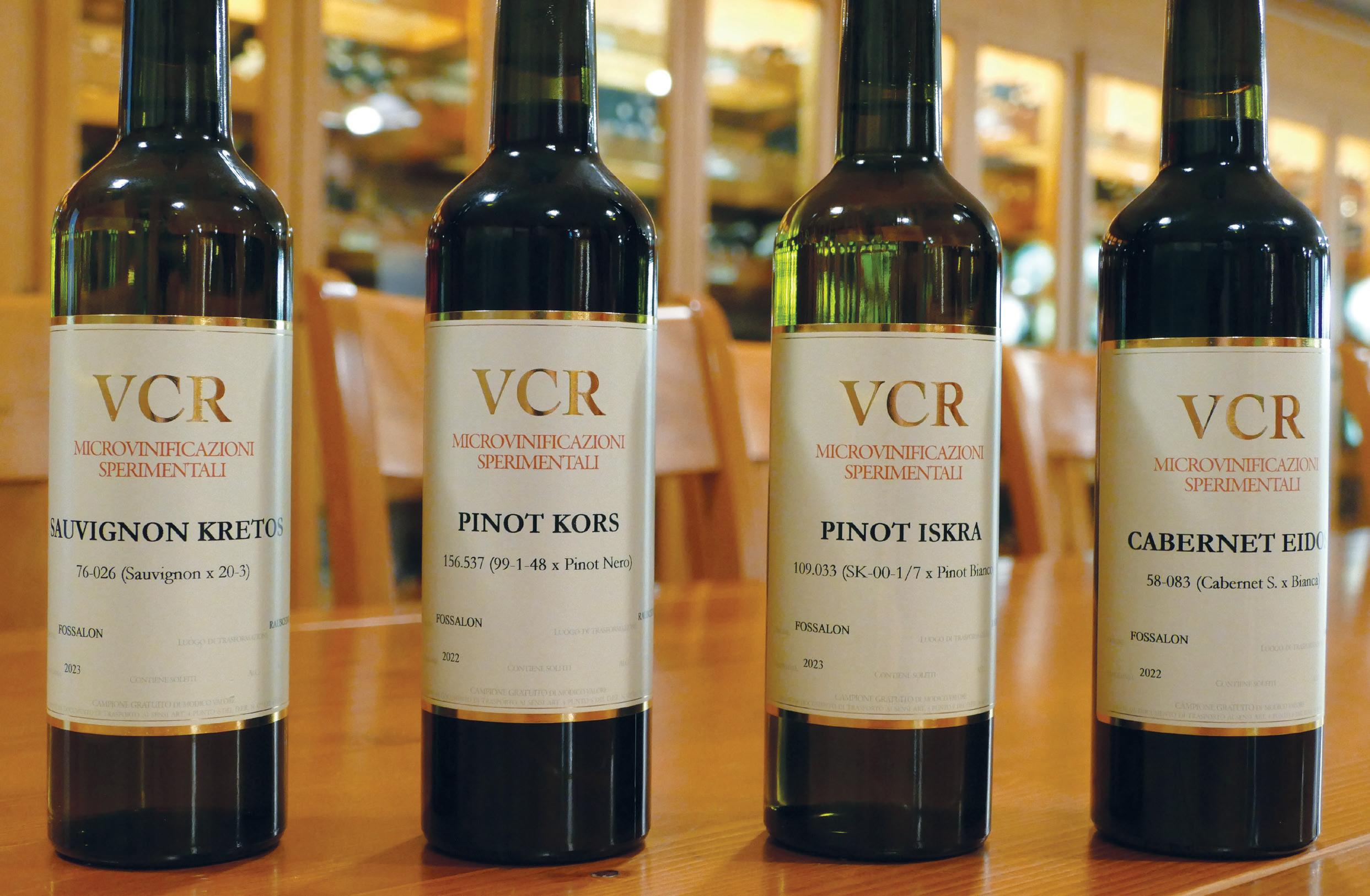

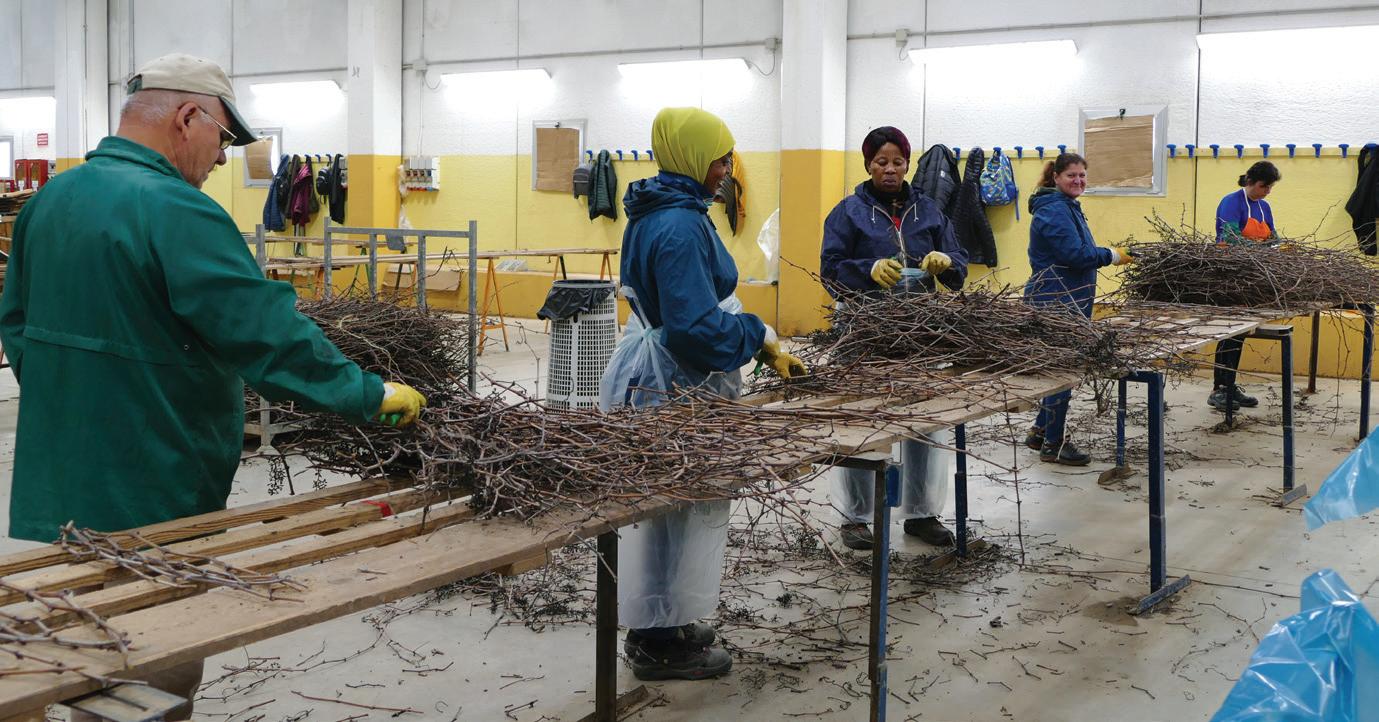

these wines have full technical and visual information available.
Something that is truly amazing is that this is a service that is free to VCR clients. “This is on top of our normal service to help the customer,” said Dr Morittu. “We are world leaders in this service,” he added. “Sometimes people come to us with no idea of what they want to plant or other times they may have an idea that they want to plant for example Nebbiolo in Brazil which is a problematic variety in the climate and soil so when I go to a client I have to go not just with the first choice but five or six choices or sometimes I

have gone through 15 varieties before they have chosen and this is where the micro and nano vinifications are so helpful.”
It is clear that VCR go to great lengths to make micro and nano vinifications that only express the grapes characteristics. On the subject of individual terroir and its influence on the wine Dr Morittu makes a really important point he said: “Terroir should only ever add something to the wine it should never take anything away.”
As the visit to Vivai Cooperativi Rauscedo came to a close I was left with a sense that this company which is a world leader in
production and research has managed to maintain its original aim of helping to produce the best vines possible. In turn those vines will produce the best vineyards and the best grapes will subsequently be the foundation of every wine that is produced. Bearing in mind how long the process of creating new clones and new varieties takes it is clear that those working at VCR today are finishing the work of their predecessors and providing the fundamentals for the work that is still to come. Innovation and expansion has only increased the synergy that is the essence of this operation.


Ensuring that vines are receiving, and utilising, the correct balance of nutrition is a year-round job, requiring as much monitoring and measurement as it does practical intervention.
The nutritional needs of vines change as they enter different stages of growth during the season; a peak level of calcium is used just after bud burst, for example, while the uptake of potassium and nitrogen is at its highest after flowering as the fruit sets.
Building the foundations for a strong and sustainable vineyard can be the work of many years, developing the soil's capacity to capture, retain and, when required, release vital macronutrients and micronutrients for
Tim Haywood, owner and vineyard manager at Astley Vineyardthe development of healthy commercial crops which produce quality wine.
Monitoring nutrients through tissue analysis of the vines is an important measure that should be taken regularly, but not an absolute indicator of health. It is quite normal for there to be some variability in vine nutrient requirements across vineyards and over different seasons. There is also a ‘normal’ range for expected leaf nutrient levels, but that estimate of what is ‘normal’ should be used as a reference point.
Production goals, vine growth and historical data should also play a part in assessing the nutritional requirements of the plants on any given estate.
Good nutrition starts with a solid foundation. Soil health is quite literally the bedrock of a successful vineyard. Analysing the physical, chemical and biological composition of the soil helps to understand nutrient availability and also how that varies

from one area of the estate to another, allowing for the precision management of nutrition.
Julian Searle, agronomist with Agrii has asserted that soil structure may be the most important factor when it comes to vine performance – “influencing how vine roots can grow through the soil profile and forage to exploit nutrient reserves,” he writes. Adding organic matter is one way of improving the structure of the soil, alleviating compaction mechanically or adding cover crops with deep roots are alternative approaches.
The key to successful nutrition is balance, as Tim Haywood, owner of Astley Vineyard near Worcester explains. Astley has recently had a successful trial of worm soil, used to help establish newly planted vines. Along with introducing worms, they have been maintaining a good soil structure through the addition of organic material like mowings, prunings and pomace, introducing a wildflower cover crop and avoiding compaction and unnecessary cultivation. But vineyard managers “need not encourage over-rich soil,” Tim said. “Vines enjoy the struggle.”
Astley Vineyard’s regime consists of seaweed as a foliar feed and targeted micronutrients based on soil and petiole tests, mainly boron and copper. The team balance this by ensuring that the vines don’t get stressed by over-cropping. They also prune to a sustainable length of cane and remove excess buds and shoots.
Astley’s philosophy holds that the better the grapes, the better the wine. They aim to pick at ideal harvest numbers – rather than being pressured by poor ripening or disease. The team do not underestimate the old saying: good wine is made in the vineyard.
Where mature vineyards have degraded soil,


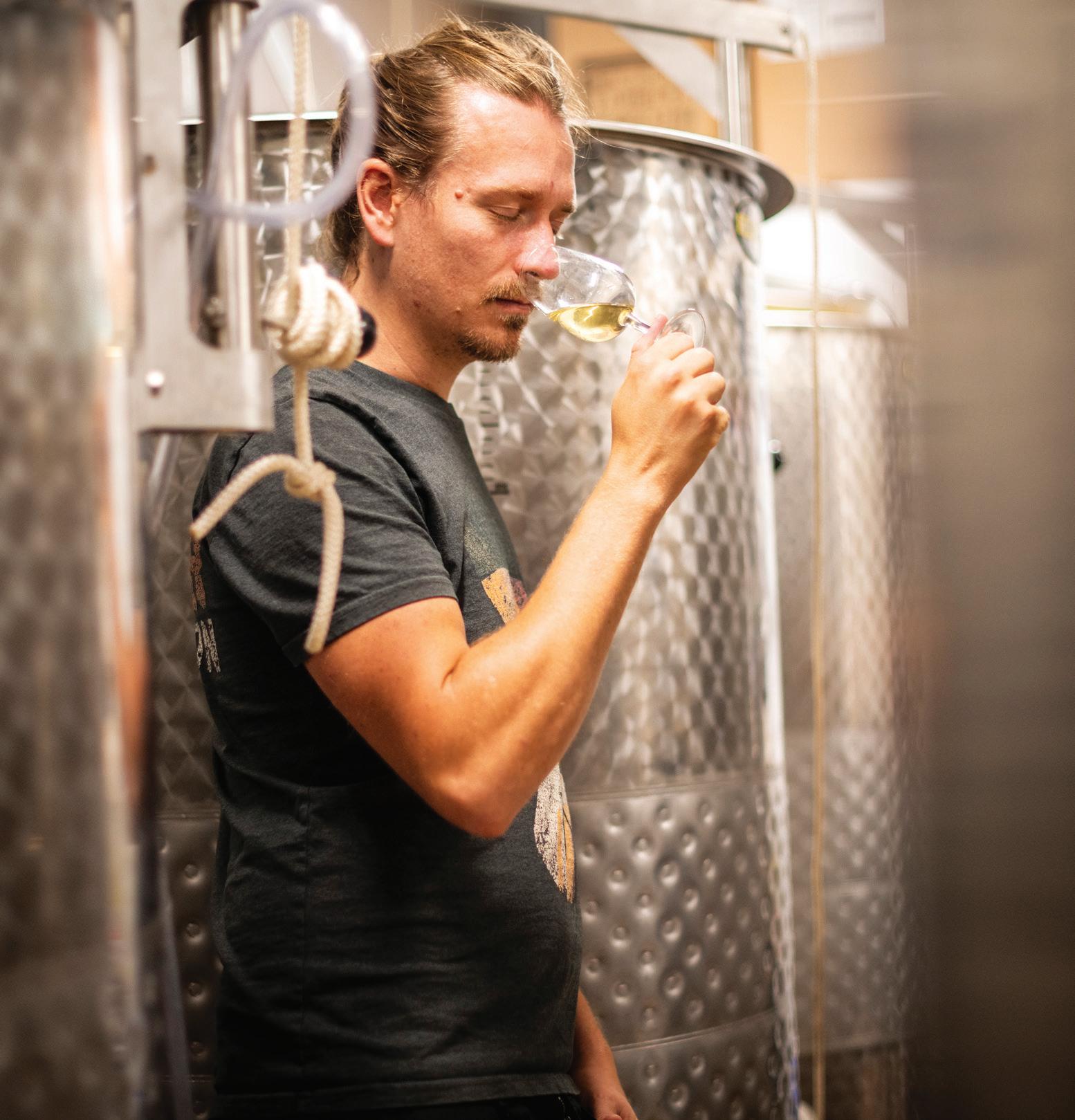
research from America suggests that applying compost in high concentrations can achieve improved soil fertility and vine performance, without any compromise in grape quality. Here, the application of steer manure (that is young, neutered male cattle raised for beef production) was found to improve levels of some macronutrients including nitrogen, potassium and available phosphorus, whilst decreasing phosphorus fixation.
As the name suggests, macronutrients are those required in relatively large quantities by the vines, as opposed to micronutrients which are needed in tiny amounts – although they are no less essential. Let’s focus on some of the key macronutrients, noting that this list is not exhaustive.










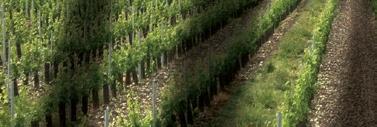

Specialized manufacturer from the southwest of France, producing steel vineyard posts since 1997.













READ THE RESEARCH: Effects of the Annual Nitrogen Fertilization Rate on Vine Performance and Grape Quality for Winemaking: Insights from a Meta-Analysis
https://doi.org/10.1155/2023/7989254
READ MORE: Potassium and Magnesium Mediate the Light and CO2 Photosynthetic Responses of Grapevines
<<
Nitrogen has a significant role to play in all grapevine processes, making it essential for normal growth. It impacts shoot growth and yield as well as the plant’s sensitivity to fungal diseases. It also influences the synthesis of primary metabolites like sugar and organic acids, along with secondary metabolites like amino acids, flavonoids and aroma compounds, so nitrogen’s presence has an important contribution to make to wine quality. A lack of nitrogen can therefore affect all key metabolic functions – hampering shoot and bunch development, for example.
The nutrient is available naturally in the soil, although different types of soils will retain it more effectively than others. Vines need nitrogen in a soluble form to be able to absorb it. Increasing the amount of organic matter in the soil contributes to the
amount of nitrogen that is plant-available. It also has the benefit of making heavier clay soils better aerated and increasing water retention in sandy soils.
Many nitrogen fertilisation trials have taken place in vineyards around the world in recent decades. A Spanish study has produced a meta-analysis of 374 such studies to try and better understand the overall trends. Those researchers have focused on the Mitscherlich law of diminishing returns as describing “the set of vine production parameters against nitrogen application rate”. They have identified optimum nitrogen requirements for maximising grape quality in their research, although these recommendations are given for general application without fine-tuning for parameters like vine age and variety. Essentially, nitrogen fertiliser can support healthy vine development up to a point, after
Wildflower strip research at Astley Vineyard

https://doi.org/10.3390/biology9070144
which the plant cannot take up any more of the nutrient and any surplus may be leached out of the soil or lost to the atmosphere.
Tipping over the sweet spot can encourage excessive vigour, leading to shading of the fruit without careful canopy management.
To effectively manage nitrogen levels, the nutrient status of the plant needs to be tested. By the time a nitrogen deficiency is visible through leaf discolouration and reduced vigour the damage has already been done, broadly speaking. A regular programme of tissue sampling gives a proactive way around the problem.
Good general soil health promotes the presence of beneficial microorganisms in the ground which will facilitate the natural nitrogen cycle and encourage better nitrogen fixation over several years to reduce reliance on fertilisers. Reducing the use of herbicides and pesticides, adding cover crops and encouraging biodiversity within the vineyard can all support the improvement of overall soil health.
When applying nitrogen, the timing is important to ensure the most efficient takeup. Vines benefit the most from nitrogen fertiliser around the time that they bloom.
A recent review of the role of nitrogen in vine balance and grape composition published in OENO One points out that nitrogen has been used extensively as a fertiliser for generations now, even though the plants only absorb around 30%-40% of what is applied. Their study concluded that “by adapting plant material, soil management and vine balance to environmental conditions, it would be possible for grape growers to improve plant nitrogen use efficiency and minimise nitrogen input in the vineyard.” Researchers also emphasised the need to balance and restrain, since an excess of nitrogen is “as detrimental to wine quality as is nitrogen depletion."
Potassium is essential to both vine and berry growth, so plants need large amounts both in the spring when the season’s growth begins and further along in the year, when the grapes develop and ripen.
READ MORE: Understanding and managing nitrogen nutrition in grapevine: a review
https://doi.org/10.20870/oeno-one.2021.55.1.3866


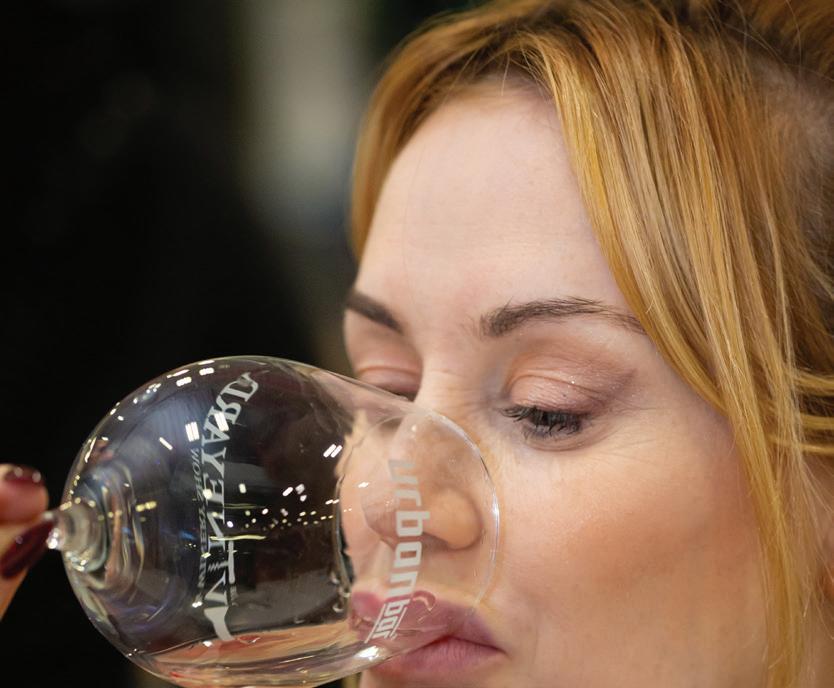









<< The efficient uptake of phosphorus increases where crop nutrition has a good general equilibrium. For example, the application of ammonium forms of nitrogen with phosphorus will increase the uptake compared to a phosphorus-only fertiliser applied separately. The absorption of phosphorus is also negatively impacted by poor soil aeration, low soil temperature or excessive soil moisture. A compacted soil decreases the volume of soil penetrated by the vine’s roots, so this will also limit their access to nutrients.
As well as impacting potential growth, a deficiency of potassium can also lead to rapid water loss from the leaves, since the nutrient helps the plant to regulate the opening and closing of stomata, the small pores on the underside of the leaves which control transpiration. Interesting research was published in Biology in 2020 that highlighted the impact on photosynthesis caused by deficiencies in potassium and magnesium, which ultimately leads to decreased biomass. The researchers observed limitations to growth both above and below ground where nutritional deficiencies had compromised photosynthesis.
As with any nutrient, potassium levels can and should be judged through a combination of soil analysis, plant tissue evaluation and visual checks for signs of deficiency in the foliage. Necrosis in the leaves or chlorosis around the leaf veins are both indicators that there is a problem. It is important to use a combination of assessment tools to check the availability of potassium because the amount recorded in the soil may not be representative of what is available for plant uptake. Taken on its own, soil assessment may give a false sense of security.
As with nitrogen, an excess of potassium can lead to excessive vigour, with all the problems that poses for grape quality. A balance needs to be struck. An early spring application of potassium can help to bolster new growth, while an application just after harvest and before leaf drop can restore what was removed when the grapes were harvested. Where a deficiency has been noted, a foliar application around veraison can give the plant the boost it needs at a key time for development.
Phosphorus holds the key to vine growth. As well as playing a role in photosynthesis, it is a component of cell membranes and supports the movement of sugars and carbohydrate storage in the vine. Without it, vigour is reduced and the leaves can yellow and drop. A phosphorus deficiency can lead to poorly formed buds at the start of the season and therefore poor fruit set later on.
Organic phosphorus in the soil comes from dead plant and animal residues and soil micro-organisms, but it is not plant-available. Those micro-organisms play a vital role in transforming organic phosphorus into its inorganic form, which is accessible to plants for nutrition. The other key source of phosphorus in the soil is in minerals. Rain and erosion can unlock it and wash it into the soil, but equally excessive water can leach the precious nutrients away.
Once again, the law of diminishing returns comes into play, as an excess of phosphorus in the soil can result in a reduced nutrient uptake overall and create excessive vigour which will negatively impact the development of the berries.
Research from the University of Leeds, Lancaster University, the University of Technology Sydney, the Agri-Food and Biosciences Institute and the Centre for Ecology and Hydrology has reported that phosphorus use across the UK agricultural sector is currently extremely inefficient. It is used excessively and unsustainably, with runoff from farms and wastewater treatment plants leading to pollution across our lakes and rivers. Researchers say that to become less dependent on phosphorus supply it is necessary to recover phosphorus that has already been leaked into the environment using emerging technologies.
Their findings have been published in the UK Phosphorus Transformation Strategy, which is available to read online: https://zenodo.org/records/7404622#.Y5rgSnbP2Uk
Magnesium is the main component of chlorophyll as well as having a role in the synthesis of proteins. Low levels of magnesium can cause premature fruit drop at harvest time and cause yellowing or redding around the edges of leaves, which will appear in the middle or towards the end of the season. Accordingly, magnesium is best applied to the soil as a long-term strategy. Foliar sprays can correct deficiencies during the season, but yield may already have been impacted.
Soil composition can play a role in the availability of magnesium. Extreme pH levels – too high or too low – can lead to magnesium deficiency, and problems have also been observed where soils contain high levels of potassium. Tissue sampling is the best way to check that magnesium levels within the plant are in a healthy state of balance and to flag whether correctional action is required.

In late 2022, Australian researchers at Charles Sturt University announced the part their work had played in developing a smartphone app that can easily diagnose grapevine nutrition deficiencies.
The work has been commercialised in partnership with global agtech company, Deep Planet, forming one aspect of their VineSignal app, which gives users a diverse set of data about their vineyard to support nutrition management strategies. The Charles Sturt team’s contribution included developing image analysis algorithms that train artificial intelligence to assess vine leaf symptoms using photos taken on a standard smartphone camera. The research was intended to help vine growers overcome the tricky problem of symptom confusion. Behind the app, the University team have built up a library of disease

images. They have automated the way user images are processed and checked against this library to make sure the tool is as fast as possible, giving immediate results. While the technology is still in beta testing, it is clear that this is a new phase in the application of technology to nutritional monitoring in the vineyard environment.
Plumpton College, a UK centre of excellence in wine education, offers an online course in vine nutrition. It is composed of a video of a WineSkills workshop along with a PDF of course materials which is aimed at vineyard managers and other senior vineyard staff. This vocational course evaluates the use of tools such as soil analysis and plant observation and discusses the use and application of organic matter, mineral fertilisers and other nutrient replacement methods.
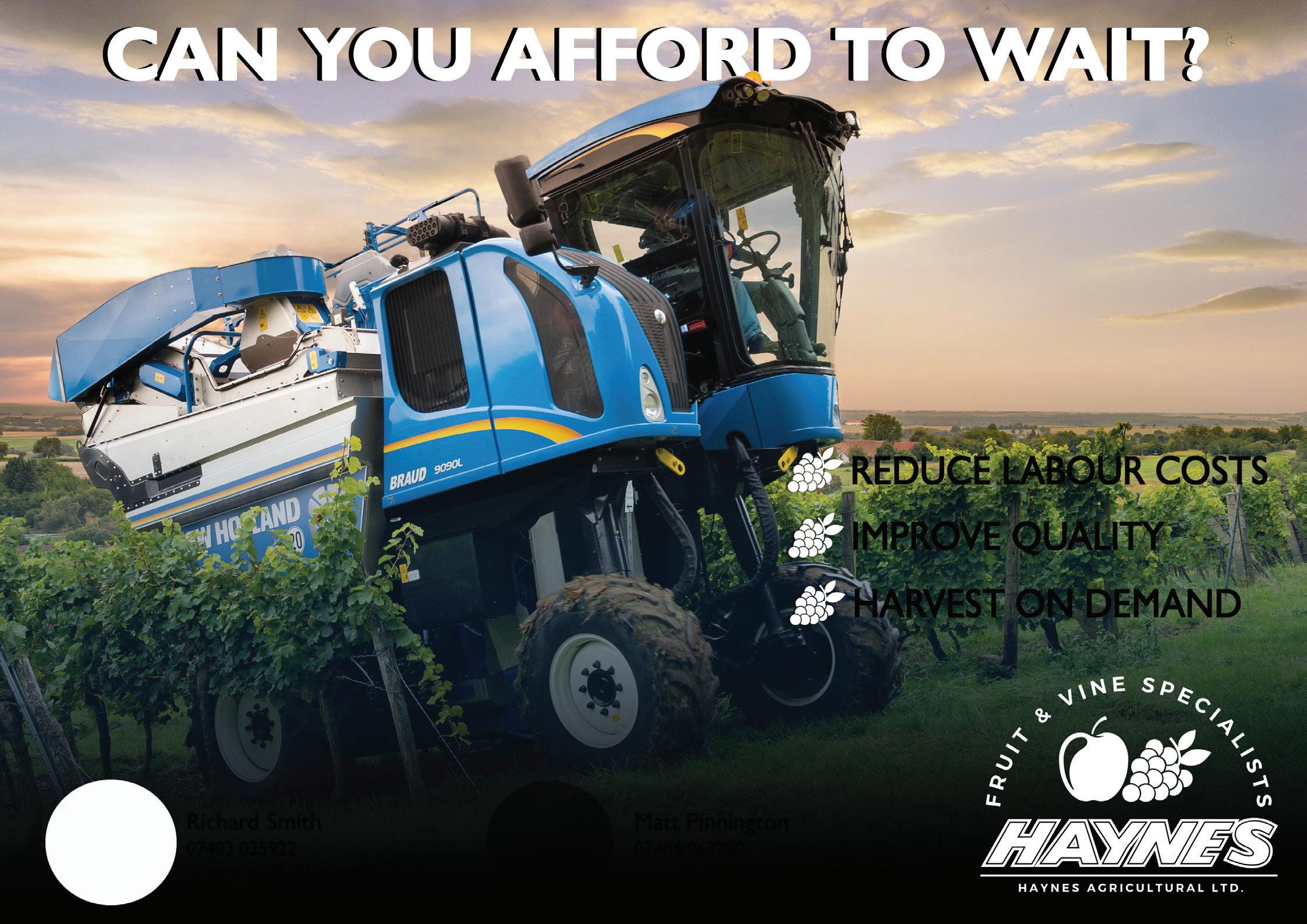


Trellising and ancillary product supply Nutrient management programmes Rootstock and variety choice Cover crop selection BASIS/FACTS qualified advisers
Product development including Agrii exclusive products
Soil management and environmental advice




Even experienced viticulturalists can be caught out by the stealth of powdery mildew, a disease which can devastate crops if the first signs are missed.
Joanna Wood talks to two growers whose vines were affected last year and explores prevention and cure.
Grape powdery mildew disease, caused by the fungal pathogen Erysiphe necator is a destructive disease which threatens vineyards worldwide and infection levels as low as 3% can taint the wine and give off-flavours.
Vigilance as the canopy develops and frequent crop-walking of every part of the vineyard are essential.
It is a disease that can easily catch you out as it sneaks along slowly and steadily inside the canopy until it suddenly appears when a spell of

conducive mild cloudy weather comes along.
In dry conditions it often remains unnoticed in shaded parts of the canopy. Optimum temperature for disease development is 20-28°C, the fungus produces about twice as many spores beyond relative humidity of 40% but is killed by exposure to UV light.
Canopies open to airflow and UV light are therefore at less risk of powdery mildew development while dense, shaded canopies provide a favourable microclimate.

It's brave to admit to having a problem but the experiences of Fiona and Bernie West last year in their vineyard in the foothills of the South Downs, a mile from the sea, are salutary.
July 2023 was wet and warm. As they started leaf stripping Fiona noticed a few grey patches on leaves, but as Bernie was applying a full spray programme they were not overly concerned.
Fiona recalls finding a small, isolated patch of powdery mildew at the top of the vineyard in the previous year and, knowing the importance of hygiene, collected and disposed of all the infected grapes well away from the vineyard, then burnt the prunings from the area.
With the benefit of hindsight, she said: “We didn’t walk the rows and inspect enough during July. Vigilance is key.”
By the beginning of August all the Bacchus berries were grey with mildew and the disease was out of control and they lost the whole crop.
It was a soul-destroying experience for the Wests, not to mention the cost of having to remove trailer loads of infected fruit and send it away to be composted. They estimate they lost 15 tonnes of crop.
Bernie reflects that their site is more humid than they originally thought, and that the sprayer wasn’t working properly.
“The sprayer has now been serviced and all the nozzles cleaned. This year I’ll use indicator papers in the canopy to check all is working correctly.”
To reduce subsequent disease pressure the prunings have been racked up and will be mulched in the alleyways although ideally, they hope to obtain a bonfire licence so they can be burnt.
There will be an increase in the number of fungicide sprays in 2024 and they plan to be even more careful with canopy management and leaf stripping.
Fiona and Bernie want to make sure that by sharing their experience they can help others avoid disease problems.
The level of powdery mildew that you inherit into season two depends on how much disease you allow to develop in season one. The spores that most influence your vineyard in early season come from your vineyard and you can control these.
Vineyards worldwide use sulphur to control powdery mildew.
To date, the disease has not developed resistance to ‘Man’s oldest fungicide’, despite centuries of use.
Commonly used sulphur products are liquid Thiopron and powder Microthiol which have effective volatile (fumigant) activity at temperatures over 20°C.
Agrii viticultural specialist Ben Brown advises: “Always apply sulphur preventatively, ideally repeating applications after rain events though modern liquid sulphurs are more persistent and can build-up too much
To find out more about powdery mildew and other diseases and pests of vines and their management and control, download a pdf of Certis Belchim’s Successful vine-growing recently updated for 2024 which is available at www.certisbelchim.co.uk/viticulture
over time if you aren’t careful.
“Higher rates of sulphur can be curative but powdery mildew spreads rapidly so it’s always best to be ahead of this.”
If you do run into problems Ben said the best thing to do is improve canopy management: “Leaf strip post outbreak – improving airflow is key – powdery mildew loves humid conditions hence it’s such an issue in the UK in wet summers.”
When it comes to spraying, Ben emphasised that sufficient water volume for good coverage is key to good control.
He also said: “We are starting to see better kickback activity from products like Cosine (cyflufenamid) and highlighted:
“In organic vineyards Amylo-X (Bacillus amyloliquefaciens subsp. plantarum strain D747) has a useful place preventatively and it works well positioned in between Botector (Aureobasidium pullulans strains DSM 149400 and 14941) sprays for botrytis for that dual control.
“Karma (potassium hydrogen carbonate) is really useful later in the season for firefighting and has been used between sulphur sprays post outbreak to bring things back under control”.
Alex Cooke, technical account manager for horticulture at Certis Belchim emphasised the importance of canopy management and deploying an Integrated Pest Management (IPM) strategy.
He added that utilising biorational fungicides Amylo X and Karma in an IPM programme with conventional fungicides like Cosine brings the variety of modes of action needed for resistance management, while being safe to beneficials and reducing residues.
“Karma’s formulation includes adjuvants to speed up sprayer filling and optimise leaf coverage and adherence, while Cosine combines both preventative and curative activity.
“Cosine’s unique vapour action also helps to get the product to areas of the plant where it might otherwise be difficult to achieve good coverage,” said Alex.







Farm Machinery Buyer will harness the combined power of two premier farming brands, bringing you unbeatable reach and many more listings.
• 1,000s of new and used farm machinery listings from across the UK
• Buyers’ Guides and News

• Greater coverage for specialist farming, including arable, livestock and dairy
• Weekly bulletins showcasing the latest machinery bargains from featured dealers
Popular listed brands:



POWERED BY
The too-oſten unconsidered bott leneck for growing production.
One of England’s most respected winemakers, with a string of awards and trophies under her belt, Emma Rice is now working as an independent winemaking consultant to both new and established wine businesses in the UK. She has been at the forefront of our industry since 2008, heavily involved with WineGB, most recently as a Director on the Board. Co-author of The Wine Producers’ Handbook – a guide to setting up a vineyard and winery in the UK, she was also a major contributor to WineGB’s New Entrants’ Guide – a useful handbook issued to all new members. As a Liveryman of the Vintners Company she represents English winemaking to the wider trade and mentors young winemakers, through the Vintners Apprenticeship Scheme, which she initiated in 2016.
In light of the large yields and abundant crop produced in 2023, and with the tirage and bottling season upon us, a frequent concern raised by wine producers, particularly traditional method sparkling winemakers, is the continual and growing need for suitable storage. Years such as 2018 and 2023 are great news for our thriving industry, with great PR and coverage in the press, and plenty of ripe grapes with which to make fantastic wine both still and sparkling. Whilst the ideal is to sell all of a vintage release within the year it is launched, the reality is more often than not an overlap between selling one vintage and bottling the current one. This situation is compounded for those businesses still growing where the volume of the earlier vintage they are selling is often far outstripped by the size of the current year’s production.
Storage of potentially five or more vintages at a time, particularly when growing your business, is an ever-present concern. The reality is sales budgets and targets are usually ambitious and often not met in the first few years as you grow your brand and customer base. This is compounded if you have any contract winemaking clients – you have zero control over their sales performance and they may well clog up your storage space for years if they are unable to turnover their stock
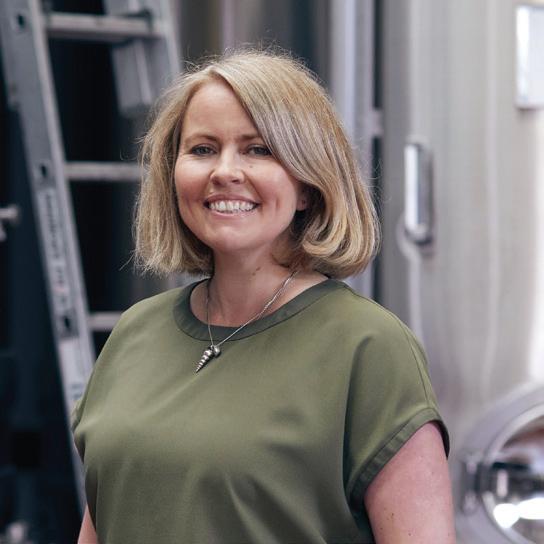
fast enough. Likewise, if you are the contract client and the winery you are using finds itself severely restricted, you may see storage charges rise exponentially as they have to build or rent more space to fit the new vintage in.
Wine stored in stillage cages, around 500 bottles per cage, can be stacked up to five cages high, where ceiling height (well over 5m to allow for manoeuvring) and forklift capacity (both for height and weight) allows. Each stack of cages has a footprint of around 1.2m2 and you need to have room within which the forklift can operate – usually around 4m of clear space, depending on the size and model. There are specialist forklifts that can work with smaller space constraints but they are usually more expensive and less versatile for other winery operations – they may also be unable to operate at the 5m height necessitating smaller stacks of three or four cages. It is worth also considering the added risk of stacking five cages high where you are unable to really see what you are doing with your forks and the fact that any incline or fall in the floor surface of your storage area will be hugely exaggerated at the height of 5m – see Figure 1.
Bottles stacked ‘sur lattes’ take up much less room but this requires some skill to perfect and adds a huge amount of extra labour to do so.

The risk of collapse within the stacks and when removing bottles is increased, and once the wine is stacked it is not easy to move before riddling and disgorging if you need to.
Thanks to space constraints for many producers, off-site storage can look attractive. The option of a third-party warehouse with good security, great temperature and light control along with efficient and easy movements in and out as required can make all the difference to the viability of a winery in terms of both space and costs (compared to building a new warehouse yourself). Of course, it has to be bonded, and with the right type of Excise licence. There are many grey areas around third-party storage for wine stored by one producer on behalf of another, especially if the third-party winery neither made the wine nor will be disgorging it. Even more so if the wine to be stored is on cork already and there are no plans to fundamentally change the product status within the producer warehouse (i.e. disgorging). Even moving wine between two warehouses on your own land can fall foul of regulation. You must ensure that any new locations that are not immediately adjacent to one another (and even then it is best to check) are covered by your producer’s licence. If you use a third-party warehouse, it is even more important to ensure that all movements are
tracked properly either by CAD (Commercial Accompanying Document) or Form W8, depending on status of the product being moved (grapes, bulk or finished wines). The HMRC Notice 163: Wine Production is the source of information you will need for making sure you adhere to the law.
As of July 2024, Carvers Hill Estate, a new vineyard business in Wiltshire, has anticipated the need for storage of wine on lees and as the finished product. They have built three separate and dedicated warehouses adjacent to their winery building. Taking advice from the outset, the storage warehouses are all temperature controlled and fully bonded, allowing them to accept wine in all states from producers in the UK and on behalf of merchants importing from other countries. The warehouses are equipped with racking for palletised wines as well as dedicated areas for stacking stillage cages. No windows and appropriate lighting along with solid steel doors and great security means producers and importers alike can store their wines safe in the knowledge that they will be secure. Ideal for long-term storage of wine to be aged on lees, the monthly fees will be very reasonable along with a simple structure for handling bulk receivals and dispatches.
Having worked in the English wine industry
OPENING JULY 2024
◆ Temperature – consistent (variation is the enemy of wine) and within the range 12-16°C
◆ Ultra-Violet light – either natural or artificial – can cause light strike and ruin the wine (particularly wine in clear glass)
◆ Security – wine is an attractive target, particularly when labelled and packaged
◆ Bonded – is the warehouse bonded with the correct Excise licences –absolutely key if the warehouse in question is offering third-party storage only – do not assume a Producer’s Licence is sufficient. If HMRC are not satisfied that the correct Excise Licence, or movement paperwork, is in place they can seize and destroy the goods and issue penalties that would kill most businesses.
for close to 20 years, latterly as a consultant to many existing and new businesses, it is the most common problem a winery faces at some point, in fact, I don’t think there is a single winery business that hasn’t faced this problem and the associated costs. Carvers Hill Estate is anticipating both its own needs and those of the wider industry. Temperature-regulated

WineGB is the national trade body representing the vine growers and winemakers of Great Britain from the largest producers to small hobbyists. Our members work together with the organisation to develop strategy, expertise and marketing opportunities for long-term, sustainable success.
If you are interested in wine production in the UK find out more about WineGB and join us. Visit our website www.winegb.co.uk
We are now accepting entries for this year’s WineGB Awards. Now in its eighth year, the WineGB Awards is the most comprehensive competition for GB wine judged by Masters of Wine and top sommeliers, buyers, retailers, and writers.
This year, the competition will be judged by a panel of nine expert tasters, chaired by Susie Barrie MW, Oz Clarke OBE, and new co-chair Peter Richards MW at the stunning Sandridge Barton in Devon.
As well as a new judging location and line-up, we have introduced an additional wine class for 2024: Aged Vintage Sparkling. This class is for traditional method vintage wines in any style, but with a minimum age requirement of 10 years (2014) or older.
Entries close on 3 May and delivery of samples must be made by 10 May. Judging will take place from 3 to 6 June and the medals will be announced on 20 June during English Wine Week. Our trophy winners will be announced at the WineGB Awards Celebration at the Drapers' Hall on 19 July.
Mark Sainsbury, owner, Candover Brook: “We were thrilled that all of the hard work over these formative years was recognised in our very first release and remain extremely proud of our 2023 WineGB Awards, which include a Gold, a Trophy for Best Regional Wine (Wessex) and




Best Newcomer. A lot of the hard work over the last ten years has been carried out in a vacuum without anyone tasting what we were doing, so to have this validation in the form of these highly regarded awards is just wonderful for the whole Candover Brook team. The impact was huge for us as a new brand; doors started opening, the telephone started ringing and people were suddenly interested in hearing our story and tasting our wines, and that is priceless. Thank you WineGB for helping plant us firmly on the English winemaking map.”
Angus Crowther, owner, Tuffon Hall: “‘Who is Tuffon Hall?’ – That was the question on many people’s lips until we entered the WineGB Awards. We are a small boutique family-run vineyard in North Essex, and to say it has put us on the map is an understatement. We can now proudly claim to have ‘officially the best rosé in the country’, and it has helped our business immeasurably.”


Robb and Nicola Merchant, owners, White Castle Vineyard: “Entering our wines into the UK’s premier wine competition presents a benchmarking opportunity. Winning gold and runner-up in the Pinot Noir producers class in 2023 and best Welsh Regional Wine represents a significant achievement and a notable accolade within the UK. Such recognition not only elevates our brand’s profile but also establishes credibility and trust among both trade professionals and consumers alike.”











 Photo: Cat Wilder
Photo: Cat Wilder

It’s that time of the year again! Block off your calendars, bring out the bunting, and get ready to pop plenty of corks.
◆ Welsh Wine Week: 24 May - 2 June
◆ English Wine Week: 15 June - 23 June
Let us know how you are celebrating this year by emailing office@winegb.co.uk




Mark Darley, Director, Enborne Vineyards Limited: “All Angels was delighted to win both a Gold Medal and Best Regional Trophy for its Classic Cuvée 2015 at the WineGB Awards 2023. Recognition from the UK’s wine industry organisation is so important to raising brand awareness and strengthening the position of our wines in the market. The acknowledged, rigorous judging criteria applied by leading wine critics gives confidence and encouragement to the consumer to try English and Welsh wine safe in the knowledge of its outstanding quality.”
Mary Bridges, Head Winemaker, Gusbourne: “At Gusbourne, we are delighted to have won several gold and silver medals, along with four trophies at the 2023 WineGB awards. The competition recognises the very best in English and Welsh wine and to win Estate Winery of the Year for a third year is a true testament to the dedication of the team. Each year as our exciting category grows the quality grows within it, and the WineGB Awards are a great way to celebrate this.”
We are very grateful to our hosts for this year’s judging, Sandridge Barton in Devon. Commenting on the new location, Duncan Schwab, CEO and Head Winemaker at Sandridge Barton, said: “We are super excited to host the WineGB Awards tasting at Sandridge Barton, in South Devon this year. WineGB sought to diversify this annual event across various regions in the UK, and we are honoured to have been selected as the representative for the West, showcasing the finest wines and wine producers in England and Wales. Cheers to good times and great wines!”
We are also incredibly thankful for the ongoing support and enthusiasm of the WineGB Awards sponsor, Rankin.
Jim Rankin, Commercial Director at Rankin Brothers & Sons, said: “We are tremendously proud and excited to return as sponsors of the annual WineGB Awards. The WineGB Awards recognises and celebrates the professionalism and depth of talent within this nascent but blooming sector. Being recognised as a winner in the WineGB Awards carries more cachet than ever before.
“The Awards encourage the drive to ever greater standards and they help elevate the status of wines produced in England and Wales to customers all around the globe. We will continue to play our part in supporting our local wine producers, wherever in England and Wales you may be.”
To enter the awards, login to the WineGB members’ area where you will find the online entry form.

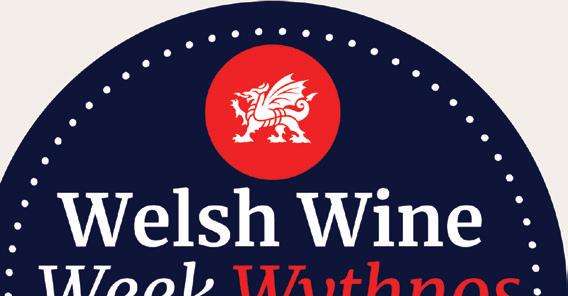




The increased pressure to improve fruit quality, reduce losses due to disease and deal with the shortage and expense of labour has led to the increased use of machinery to strip leaves in the grape zone.
The Alsatian company Provitis offer two types of stripper, the suction roller type LR 350 but also the pneumatic type LB 260. The latter uses rotating jets of air at 0.6 to 1.0 bar to shred the leaves. A blower generates the air pressure passing it to the rotating nozzles which strip the leaves. The working height in the grape zone can be adjusted from 400mm to 640mm by tilting the heads. With the leaves gone, better airflow through the canopy contributes to drying and therefore less disease incidence; spraying is more effective as fungicides can be applied directly onto the berries.
When used early in the season it helps blow the caps off the emerging flowers and when used the day before or on the day of harvest greatly reduces hand picking time. Different models are available to work on half a row (single head), two half rows (two heads left and right) or a complete over row with two heads. The compressor blower is always at the rear of the tractor but the heads can be at the front and if a Provitis mast is already used for trimming or pre pruning a stripper head can be added. www.provitis.eu





















Makita has added two new pruning products to its ever growing outdoor product range. Powered by Makita’s 18V LXT battery system, the new DUP180 Brushless Pruning Shear and the DUC150 150mm Pruning Saw offer a comfortable and powerful solution to make quick and light work of repetitive or heavy pruning jobs.
With an adjustable shear blade opening angle, the new DUP180 18V LXT Brushless Pruning Shear accommodates four different cutting capacities up to ø30mm and provides up to 8,800 cuts on a single charge (when used with a 6.0Ah battery).
Thanks to a brushless motor and belt holster to carry the battery, this tool is extremely lightweight and comfortable to use at just 0.68kg (without battery). To further minimise user fatigue, Makita has engineered the tool so that the control of the shear blade is interlocked with the trigger, meaning the blades will only open and close depending on the degree the trigger is depressed or released.
Additionally, an external oil port is designed for easy blade lubrication without disassembly, enhancing the tool's durability.
Joining the outdoor line up is the DUC150 18V 150mm Pruning Saw. Operating with a chain speed of 8m/s, this compact machine offers excellent cutting performance despite its lightweight design.
Additional comfort and efficiency-enhancing features include tool-less chain tensioning and automatic chain oiling, while a brushless motor ensures low maintenance requirements and a longer working motor life.
The DUC150 is available as a kit with a BL1850B Battery and DC18RC charger, or as a standalone tool body only.
Kevin Brannigan, Marketing Manager at Makita UK commented: “Whether it’s for making light work of clipping back shrubs and hedgerows, or trimming branches and small trees, the DUP180 and DUC150 are convenient tools that are designed with simplicity and

ergonomics in mind. At Makita, we continue to apply our heritage and expertise in battery technology and tool engineering to develop essential kit items such as these, so that the professional sector has access to a vast range of battery powered tools that meet every daily demand without the constraints of cords or petrol.”

It is well known that mechanical weeding is just as effective as herbicide when it comes to vine health and increasing yield.
A three-year integrated weed management trial, IWMPRAISE, which was carried out on Chardonnay at NIAB EMR’s Kent-based research vineyard, effectively proved that all the mechanical weeding methods which were trialled positively impacted the health of the vine as well as the yield.
Data also showed an insignificantly small difference between the mechanical and chemical treatments in vine vigour, nutritional status, inflorescence counts, and yield.
Looking at weed abundance and coverage too, mechanical weeding successfully resulted in an overall decline in total weed coverage over the growing seasons in the trial.
One of the mechanical weeding tools used in the trial was a rotary star tiller and finger weeder. Instead of breaking the soil, rotary tiller weeders effectively move through it, making it more friable, light, and fluffy. The horizontal finger weeder then distributes and levels the soil. This creates an inhospitable environment for weeds looking to establish themselves.
The Braun Rollhacke rotary star tiller has been identified as the best on the market and is the clear weapon of choice for vineyard managers across the UK, having proven to be adaptable to different soil types.
With 60ha of vines on Wealden Clay with Tunbridge Wells sand in Appledore, Kent, and 30ha on flinty, clay loam over chalk in Halnaker, Sussex, Gusbourne Estate has several tractors equipped with double-sided Braun Rollhackes.
Having seen how popular they were in Germany, Gusbourne’s chief vineyard manager Jon Pollard started using the




Rollhackes as soon as NP Seymour started importing them.
“Initially, we were going to do a trial, but the Rollhacke did so well in the first plot that we decided to use it across all sites, and we have had above-average yields in all the years since,” said Jon.
For those worried that mechanical weed control will increase compaction or fuel consumption, Jon said that the Braun equipment, which is put through the vineyard around 12 times per year, is mostly combined with mowing operations.
“If we didn’t have the Rollhackes we would still be mowing the alleyways eight times per year, and we would be doing four passes of herbicide, so our overall tractor movements would be no different,” said Jon. “When it comes to the soil structure, too, you are only turning the top four or five inches, not going down where the vine roots are and so I feel there are no issues there with soil biology.”
For those who do not want to impact the soil in any way, Braun has also developed the Vine Trunk Cleaner. While initially brought to market to help growers with the backbreaking task of bud rubbing, this strimmer-like machine effectively controls unwanted vegetation growth and weeds between the vines. Growers can choose to mount the units on NP Seymour’s bespoke front-mounted tool carrier, or alternatively, they can be attached to the Braun mid-mounted vertical hydraulic lift arms.
For those looking for optimal efficiency and wanting to combine mechanical weeding and mowing tasks, the Braun Vine Trunk Cleaners can also be easily fitted onto a variable-width Braun Alpha mower.
The Braun Alpha variable width can be hydraulically adjusted depending on the model as standard. Growers can also opt for the upgraded Sensotronic, which uses a sensor to detect the rows and continuously adjust its working width while driving.

















The Grapevine Podcast was conceived by Mike “MYK” Wood, a radio presenter, producer and media production specialist, in partnership with Itasca Wines founder Malcolm Walker, born from their collaboration on the TV series Cellar Rats. The idea was to produce an industry live, visual “show” instead of a generic audio podcast. The aim is to attract an industry audience as opposed to the general public. The podcast is targeted at the wine industry, vineyard owners, growers and winemakers. Guests will be industry insiders, experts in their chosen fields and disciplines as well as celebrities from the world of wine, telling their stories, asking advice and discussing innovations and technology across both the UK and worldwide.
EPISODE 1
Featuring Elizabeth Harrison Butler, the Marketing Director for Itasca Wines and Penn Croft Vineyards. Host MYK discusses the history behind the wine business, and the UK wine business, and how Itasca and Penn Croft are thriving in a di cult market where UK wine is yet to be considered a producer of quality, fine wines.
www.youtube.com/live/iz1w13dAJ4w
EPISODE 02
The Grapevine interviews Simon Porter, Farmer and Vineyard Manager for Penn Croft Vineyards in the UK. Simon is an expert on sustainable farming methods and built Penn Croft Vineyards specifically focussed on sustainable farming.
www.youtube.com/live/AuNdb7C2T6M
EPISODE 03
ITASCA WINES WITH FOUNDER MALCOLM WALKER
Malcolm’s idea to build a winery and wine business in the middle of the lockdown seems like a crazy idea, yet today the Itasca Wines business is thriving in the UK. So how did he do it? www.youtube.com/watch?v=Or8rpiQ7jrQ